
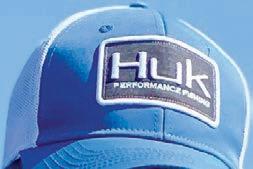
Only $4.95 July 2023 TSFMAG.COM TIDE PREDICTIONS & SOLUNAR FEED TIMES INSIDE! Gov. Abbott Signs CCA-Backed Oyster Bill Into Law Trout & Redfish Bite Heats Up Coastwide Outstanding Nearshore & Surf Action
Introducing a new chapter in Total Boat Control with the Power-Pole MOVE™ Brushless Trolling Motor. These two models conquer the harshest conditions with unrivaled power, unmatched durability and unbelievable efficiency that operates with near absolute silence. Go farther. Fish harder. Make every move count.








Power-Pole.com
Your Local Dealer.
Now Available At



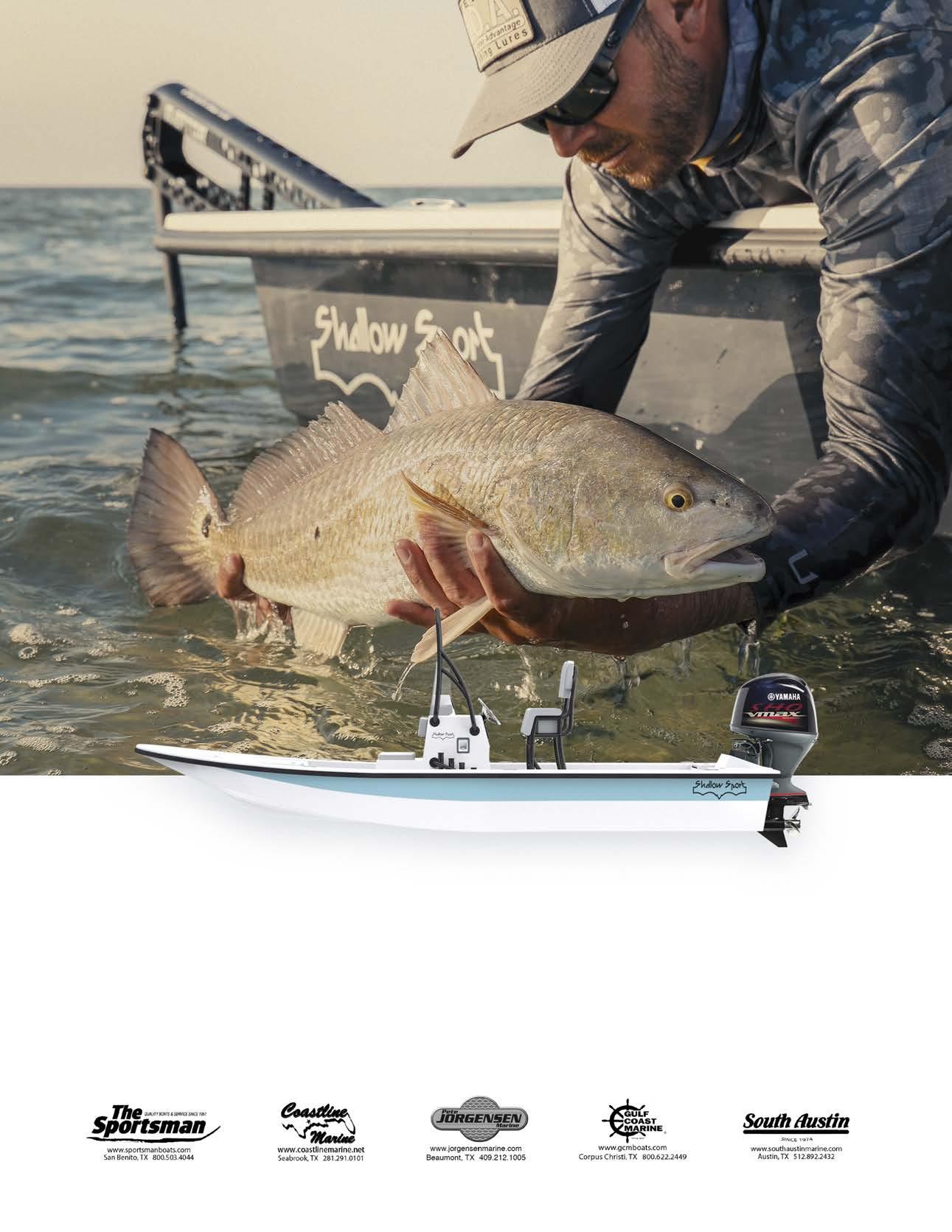

www.ShallowSportBoats.com Draft on Plane Draft at Rest Hole Shot Draft 4” 8” 10” The SPORT takes on rougher water with an unbelievably comfortable and dry ride. Hands down, the SPORT is our most popular model for guides and seasoned anglers.
21 SPORT
Powered By
Best all-around fishing machine
(Image from Interactive Builder)
Chuck Uzzle, longtime TSFMag contributor, is this month’s cover angler. Chuck tricked that husky, Sabine marsh red he’s holding with a MirrOlure She Pup. Chuck says the trout bite on Sabine has rebounded this spring to the best anglers have seen in years…and the reds just keep on coming! He urges carefully handling to ensure full revival of redfish after prolonged battles in hot summer marsh and lake waters.

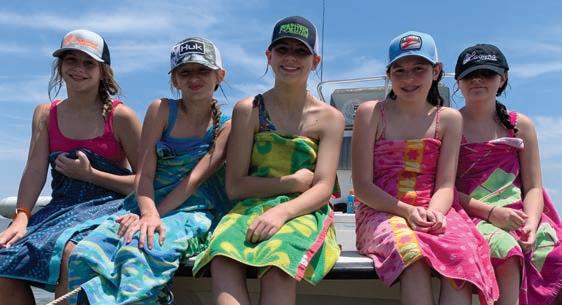

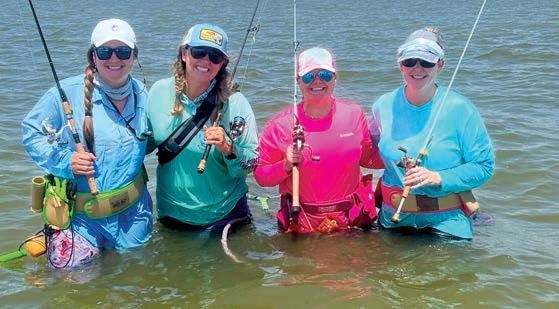


WHAT OUR GUIDES H AVE TO SAY 62 The View from Matagorda Bink Grimes 64 Mid-Coast Bays with the Grays Shellie Gray 66 Hooked up with Rowsey David Rowsey 68 Wayne’s Port Mansfield Report Wayne Davis 70 South Padre Fishing Scene Ernest Cisneros REGULARS 6 Editorial 60 New Tackle & Gear 72 Fishing Reports and Forecasts 76 Catch of the Month 78 Gulf Coast Kitchen DEPARTMENTS 36 Let’s Ask The Pro Jay Watkins 40 TPWD Field Notes Joel Anderson 44 Shallow Water Fishing Dave Roberts 46 TSFMag Conservation News CCA Texas 50 Fishy Facts Stephanie Boyd 54 Extreme Kayak Fishing & Sharks... Eric Ozolins 58 Mostly Sight-Fishing Jake Haddock 53 Science & the Sea UT Marine Science Institute 80 Boat Maintenance Chris Mapp FEATURES 10 Nook & Cranny Fishing 101 Steve Hillman 16 Misleading Numbers Kevin Cochran 22 Gaining Ground: Fisheries in Recovery Chuck Uzzle 26 Hunting for Surf Trout Joe Richard 32 Shallow Sport Tourney Recap TSF Mag Staff 34 Trout Tagging Texas Chris McKinley 22 44 78 64 JULY 2023 VOL 33 NO 3 CONTENTS
ABOUT THE COVER
4 | July 2023
EDITOR AND PUBLISHER
Everett Johnson | Everett@tsfmag.com
VICE PRESIDENT

PRODUCTION & ADVERTISING DIRECTOR






















Pam Johnson | Pam@tsfmag.com
Office: 361-785-3420 Cell: 361-550-9918

NATIONAL SALES REPRESENTATIVE


















Bart Manganiello Bartalm@optonline.net


REGIONAL SALES REPRESENTATIVES
Pam Johnson | pam@tsfmag.com
Office 361-785-3420 Cell 361-550-9918


















Everett Johnson | everett@tsfmag.com
Office 361-785-3420 Cell 361-550-3637























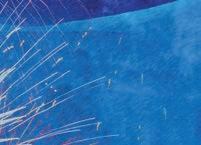

PRODUCTION COORDINATOR
Donna Boyd Donna@tsfmag.com

CIRCULATION

SUBSCRIPTION – PRODUCT SALES
Vicky Morgenroth
Texas Saltwater Fishing Magazine (ISSN 1935-9586) is published monthly by Texas Saltwater Fishing Magazine, Inc., 58 Fisherman’s Lane, Seadrift, Texas 77983 l P. O. Box 429, Seadrift, TX 77983 © Copyright 1990 All rights reserved. Positively nothing in this publication may be reprinted or reproduced. *Views expressed by Texas Saltwater Fishing Magazine contributors do not necessarily express the views of Texas Saltwater Fishing Magazine. Periodical class permit (USPS# 024353) paid at Victoria, TX 77901 and additional offices.
POSTMASTER: Send address changes to Texas Saltwater Fishing Magazine, Inc., P. O. Box 429, Seadrift, TX 77983.



















Store@tsfmag.com DESIGN & LAYOUT Stephanie Boyd Artwork@tsfmag.com SOCIAL MEDIA COORDINATOR Jen Shive Jen@tsfmag.com Texas Saltwater Fishing Magazine is published monthly. Subscription Rates: One Year (Free Emag with Hard Copy) Subscription $32.00 E-MAG (electronic version) is available for $15.00 per year. Order on-line: WWW.TSFMAG.COM MAKE CHECKS PAYABLE TO: Texas Saltwater Fishing Magazine Attn: Subscriptions P.O. Box 429, Seadrift, Texas 77983 * Subscribers are responsible for submitting all address changes and renewals by the 10th of the prior month’s issue. Email store@tsfmag.com for all address changes or please call 361-785-3420 from 8am - 4:30pm. The U.S. Postal Service does not guarantee magazines will be forwarded. HOW TO CONTACT TSFMAG: PHONE: 361-785-3420 FAX: 361 792-4530 MAILING ADDRESS: P.O. Box 429, Seadrift, Texas 77983 PHYSICAL ADDRESS: 58 Fisherman’s Lane, Seadrift, TX 77983 WEB: www.TSFMAG.com PHOTO GALLERY: photos@tsfmag.com PRINTED IN THE USA.
FUEL YOU USE in your vehicles and equipment is evolving every day. New fuel chemistries and new regulations require a new approach to treating fuel issues.
TRON is designed specifically for modern fuels—including fuels containing ethanol—as a truly multifunctional fuel treatment.
TRON is an ideal all-season, all-purpose treatment that is proudly MADE IN THE USA. START up with ease. Every time. RUN faster, cleaner, smoother. STORE with confidence between use.
MADE IN THE U. S. A . THE
STAR
STAR
BUILT TO RESPOND
WELCOME TO THE FIRST FULL MONTH OF SUMMER!
Ready or not, summer has arrived in all it’s glory. Fishing opportunities abound as anglers and angling families rush to the coast. Having held the job of this publication’s editor more than twenty years, I do not recall ever receiving as many favorable fishing reports from our team of contributing writers – covering every region, bay system, surf, and nearshore gulf. Two words; blessed and thankful, keep popping into my head. We are definitely blessed to be able to enjoy such bounty, and we should be forever thankful for the efforts of TPWD and all the conservation organizations that have lent vision, hard work, and undying effort to help accomplish it. It wasn’t always this way; and it is now our responsibility in stewardship to endeavor to further conserve these resources for future generations.
A great step forward was accomplished recently in the management of our oyster fishery, and I want to direct your attention to the article from CCA Texas in this issue:


Signed by Governor Abbott on May 27, 2023, Senate Bill 1032 will go into effect on September 1, 2023, providing Texas Parks and Wildlife Department (TPWD) and stakeholders with the opportunity to develop a new(ish) program – The expansion and creation of on-bottom oyster leases. This bill is a common-sense approach that will provide stability, certainty, and increased business opportunities for the oyster industry, as well as substantial restoration opportunities for conservation organizations.

This is landmark stuff, folks. Whether or not you might be aware, oysters are far more than a seafood delicacy. They create an incredible network of habitat vital to the health of more than half of Texas bays, including the spotted seatrout and red drum we covet so dearly. They also greatly enhance water quality and contribute to literally hundreds of other species so vital to the maintenance of the marine food chain. It’s been a long time coming and I salute all who played a role in this accomplishment. Be sure to read the full article. Like I said, this is landmark stuff.
July is going to be a busy month on the water and I would be remiss if I did not offer encouragement for everybody to be on their best behavior and respect the rights of their fellow anglers and boaters. Little things, like making sure all your gear is onboard before backing down the launch ramp. Switching off your headlights while launching, so you don’t blind the guy in the other lane. Slow down in busy sections of channels. Yield right-of-way, even if you’re in the right. Last but not least…don’t crowd your fellow angler.
Have a Safe and Happy Independence Day!

EDITORIAL
© 2023 Sea Tow. All rights reserved. Are you a member? Unlimited towing with no distance or dollar limits in your home area Priority service for members 100% tow coverage to repair facility on all covered vessels Offshore coverage seatow.com /txsw
View The Video Open Camera and hover over QR Code. When link appears at top of screen tap to open in YouTube. July Issue Highlights 6 | July 2023
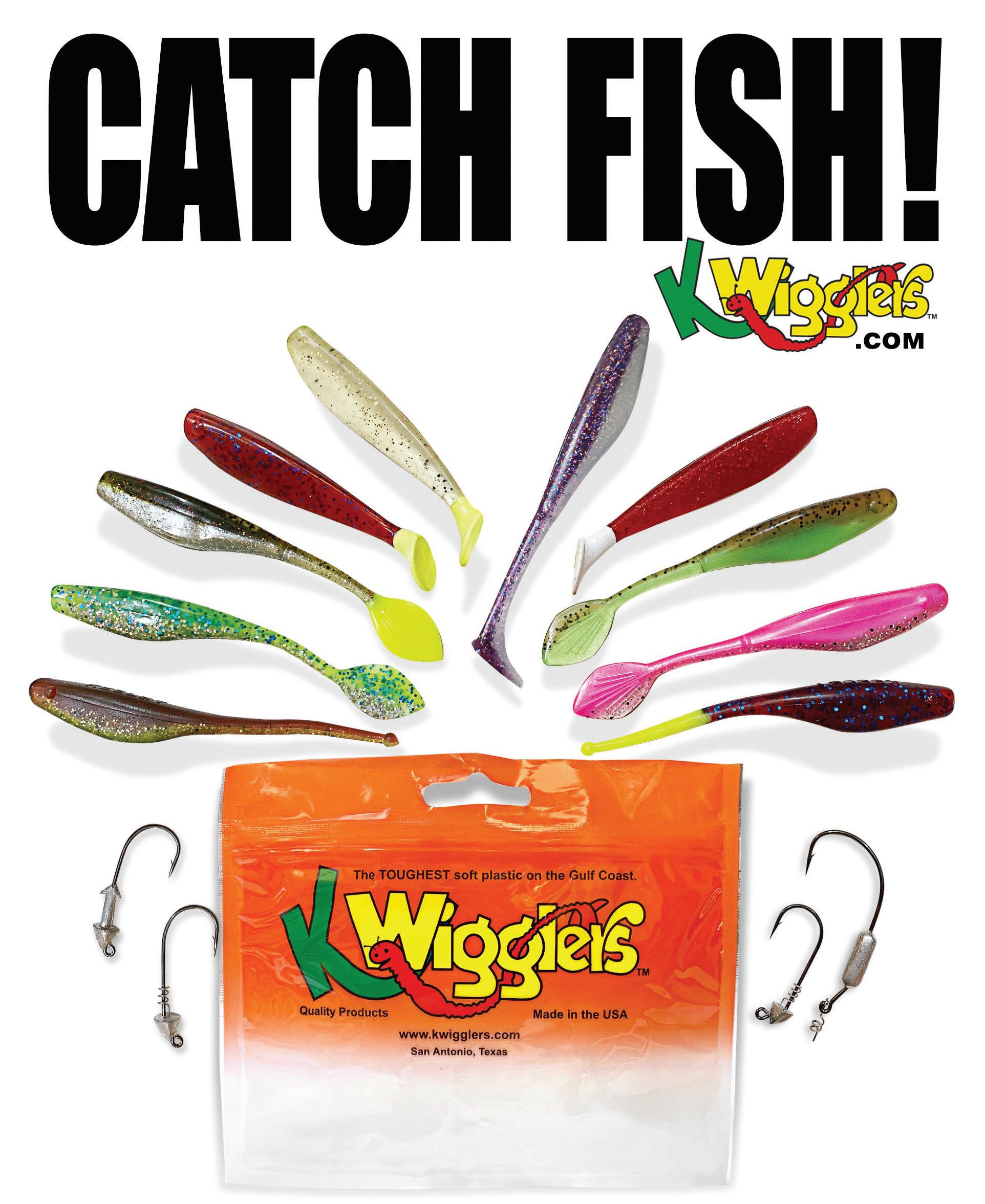
Boat Dockter

Viaggio’s Diamante Series stands alone in the market as the most luxurious and well-built pontoon boat available! With our exclusive Matte Metallic finish and heavy 3” rail system, the Diamante is built to last and turn heads every time you hit the water.


[dee-a-mont-eh] (noun), Italian for Diamond


8 | July 2023
For optimum performance and safety, read the
a personal flotation device while
-OR-
read your
Owner's Manual before operating your Honda Marine Product. Always wear
boating.
Always wear a personal flotation device while boating and
owner's manual.




TSFMAG.com | 9 COACH CRAFTSMANSHIP | 263 FLC We believe our construction quality is second to none in the industry, and we think you will agree! Delivering an owner experience that is effortless and enjoyable every step of the way is our goal. EXPERIENCE TRUE CRAFTMANSHIP Boat Dockter 7650 PARK ROAD 4 WEST BURNET, TX 78611 NOW OPEN 2nd Location! 525 FM 1431 KINGSLAND, TX 78639 512-756-5000 boatdockter1@gmail.com boatdockter.com Dockter
This healthy speck (released) exploded on Dutch Duckett’s MirrOlure She Dog as he was “walking the dog” down the edge of a shallow oyster reef during a late morning minor feeding period.
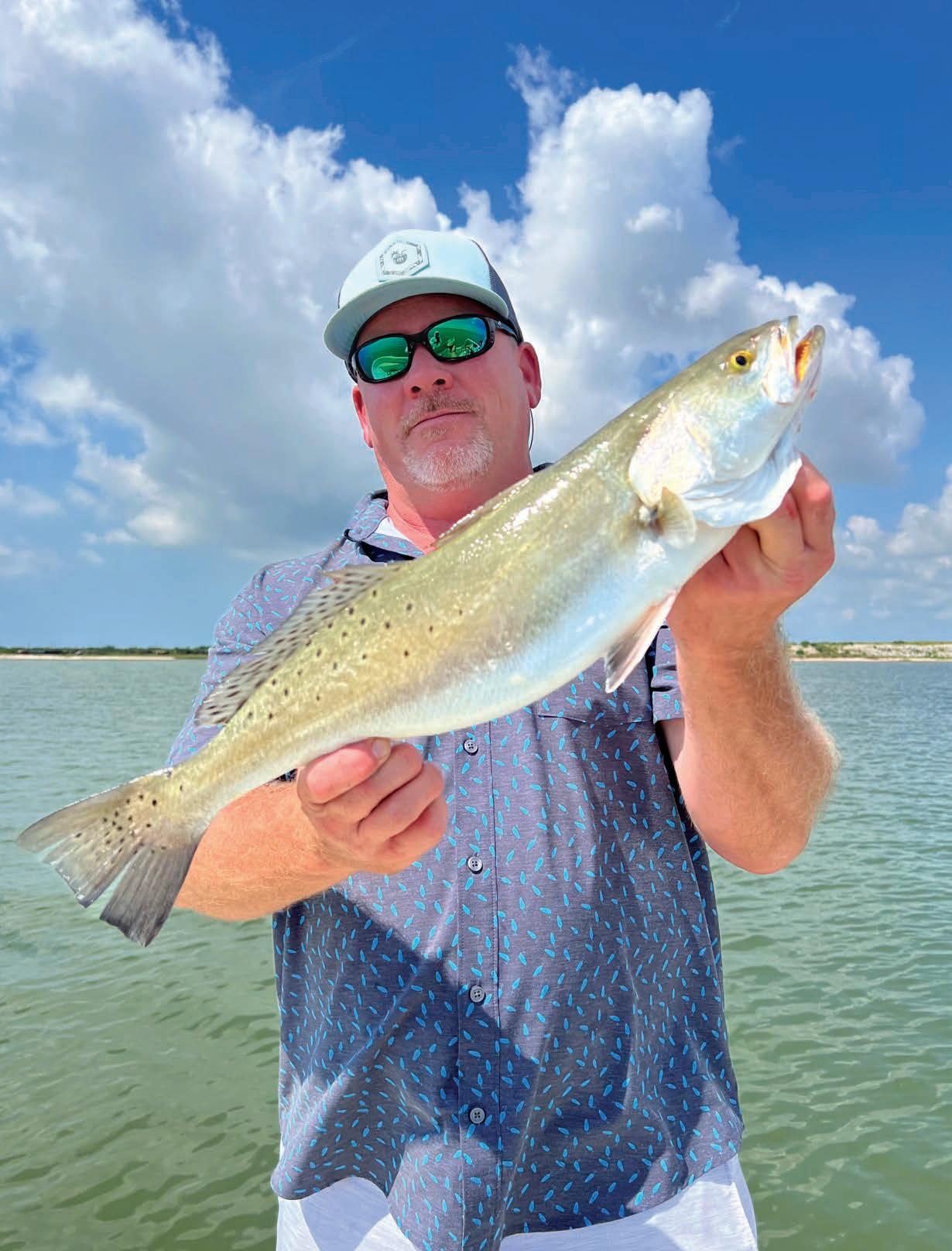
TOP OPTIONS FOR Mid-Summer Success ON Galveston Bays
STORY BY STEVE HILLMAN
Summer is in full swing and fishing patterns are as predictable as can be. As long as bay-wide salinities and water temperatures remain stable there’s really no reason for our trout to relocate. So let’s talk a little bit about where we should focus our attention for the next few months to get the best results.
Mid-bay Reefs
The Galveston Bay Complex boasts many oyster reefs but not all are created equal. After years of storms, floods, and droughts many are either dead or silted over. Just because a map or the software on our GPS shows that we’re drifting over an oyster reef doesn’t necessarily mean that particular reef still exists. Or, the reef may have been changed so much since that mapping software was created that we have to mark our own waypoints to show the actual modern day landscape of the bottom. It’s nearly impossible for the occasional weekend angler to know which part of a reef is alive and which is dead. Oftentimes, however, rafts of mullet and/or pods of shad will congregate over live portions of the reefs. Slicks are also likely to pop up making it even easier for us to narrow down our target areas.
We don’t have as many of those eccentric humps and ledges that we used to have but there are still some. As with just about every species of fish in both fresh and saltwater, these are prime target areas when we can find them. Other than using whichever bottom reading technology we may have, there are a few ways to locate humps and drop offs. Similar to how we find patches of live reef, mullet and other forage species will tend to hold tight to shallower areas on the reefs. During periods of swift currents, rips and eddies will form around the shallowest parts of the reefs. Here in Galveston Bay large swells created by ships will break over shallow areas.
Various topwaters cast on top of the crests of the humps and then walked along the drop-offs have produced some great catches for us recently, especially when we see lots of active mullet on the surface. MirrOlure She Dogs, Rapala Skitterwalks and Super Spook One Knockers are my top three choices. Of course, you usually can’t go wrong when throwing soft plastics. Saltwater Assassins in both the 5-inch rattail as well as the 4-inch Sea Shad are my go-to baits.
TSFMAG.com | 11
Structure
I’ve touched on this many times in recent years but it bares revisiting. As I’ve mentioned, many of our reefs these days lack the features necessary to consistently hold great numbers of fish. Furthermore, when trout are not congregated in large numbers we don’t tend to see the slicks or the multitude of slicks we’ve experienced throughout the years. Because there are only so many hours in a day and our boats can only hold so much fuel, riding around until we see trout signs such as slicks sometimes isn’t often a viable option. This is when I resort to targeting structure.
There is no lack of structure in the Galveston Bay Complex. As much as I tend to bellyache about man-induced changes, the addition of various types of structure in our bays is actually something for which I am sometimes thankful. It would take at least three pages in this fine magazine to list the man-made structures within our complex that have been created throughout the years but spending some time on Google Earth can be a tremendous asset in this department. So, as a general overview, here are the key structure areas I like to target during this time of year:
• Erosion control rocks along shorelines
• Designated spoil islands surrounded by rocks
• Piers and Bulkheads
• Jetties
• Beachfront Rock Groins
• Oil and Gas Wells
• Wrecks (sunken boats, barges, etc.)
It’s important to keep in mind that for every rock we can see above the water’s surface there are many more beneath the surface. These submerged rocks are covered with algae, barnacles and oysters, all of which support various species of marine life which attract specks, reds and flounder. Over time we learn where the sweet spots down below are and mark them on our GPS. The same also applies to wells, wrecks and other types of structure. It’s what’s below the water line that matters most.
Beachfront
Excellent numbers of trout can be found in the surf throughout the summer. The key is timing. This is especially true here along the Upper Texas Coast. Wind plays a vital role in when we can have success fishing the beachfront. Galveston is obviously closer to the mouth of the Mississippi River than our friends farther down the Texas Coast. Because of this the longshore current which carries silt and sediments westward down the Gulf Coast eventually reaches the waters along our shallow beaches. This coupled with moderate to high winds can cause our surf to have that ugly brown appearance at times. As a general rule, beachfronts from the Coastal Bend through Port Isabel enjoy many more fishable days than we do because of deeper water and minimal silting effects from the longshore current. There are other factors affecting water clarity such as freshwater inflow, surface currents, upwellings, etc. but those variables tend to be less predictable.
My favorite time to fish our surf is during the first couple of calm days when the water is sandy green. After the third or fourth day of calm winds the water can actually get too clear making it difficult to trick quality specks using lures. When fishing the beachfront it’s imperative to follow bait concentrations. Rafts of mullet tend to be my primary focus but we’ve also had great success working birds, especially when those jumbo white shrimp are tight to the beach, which typically occurs from late June through the end of July, most years. One of our best days in the surf last year was spent casting bone MirrOlure Top Dogs from the boat onto the first sandbar as giant white shrimp were getting blasted out of the water by 2- to 4-pound trout.
Shallow Flats and Sandbars
Many anglers believe that when the summer heat hits it’s time to fish exclusively in deeper water where temperatures are cooler and provides more oxygen for fish to maintain a healthy comfort level. While this is certainly true, especially during prolonged stretches of


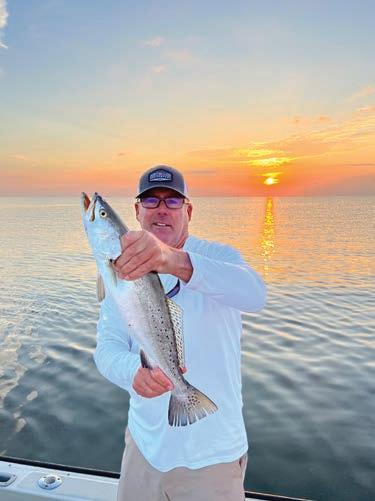 This chunky one absolutely smoked my Skitter Walk the instant I paused it amidst mullet blanketing the surface. (CPR)
Clint Brown and his dad, Joe, had a blast chasing open water schools of giant reds. Sometimes the jackfish are mixed among them.
This chunky one absolutely smoked my Skitter Walk the instant I paused it amidst mullet blanketing the surface. (CPR)
Clint Brown and his dad, Joe, had a blast chasing open water schools of giant reds. Sometimes the jackfish are mixed among them.
12 | July 2023
Bobby Wills Jr. put on somewhat of a clinic catching solid tide runner trout on this particular morning! The Chicken On A Chain Bass Assassin Sea Shad was his best bait.

calm and scorching hot days, there are exceptions. Most of the bays along the Texas Coast have various types of passes and cuts allowing water exchange to and from the Gulf of Mexico. During incoming tides, these passes breathe life into our bays in the form of slightly cooler oxygen-rich water. This creates a scenario where baitfish and predator fish such as trout and redfish become rejuvenated causing feeding frenzies, sometimes in knee- to waistdeep water even in the middle of the summer. My clients and I take full advantage when patterns set up this way and the beauty of it is that we can have an entire shoreline to ourselves because a lot of folks are stuck on the deep water over shell mindset, simply because of the time of year. In addition to soft plastics rigged on 1/16 ounce lead heads, topwaters and twitchbaits can be a real rush when they get slammed by these energetic tide runner trout. Texas Custom Double Ds and Borboleta Leles are my top two favorite twitchbaits. Working them just below the surface beneath rafts of horse mullet can result in some violent trout strikes!
Open Water Schools of Redfish


When conditions allow, chasing open water schools of redfish can be a ton of fun. Unlike trout, reds in the open bay don’t necessarily stay near live habitat or structure. Instead, they follow bait concentrations such as shad, shrimp and cutlassfish (a.k.a. ribbonfish). Large terns and sea gulls hovering and spinning frantically over these schools are dead giveaways. I’ve often noticed that birds working over these schools tend to be more elevated compared to those working over trout. In addition to using birds to locate these herds of “saltwater armadillos”
(I stole that one from Captain Randall Groves) mud boils and slicks can point us in the right direction.
Up until about 10 years ago, finding mid-bay schools of slot reds (20-28 inches) was the norm but in recent years the vast majority of our schools throughout the Galveston Bay Complex are oversized reds. The reds in most of these schools seem to range from 32 to 44 inches. I’m not exactly sure what’s caused this change but I’m not the only one who has noticed it. For the record, I’m referring to open water schools, not some of the smaller pods of reds we sometimes find in back lakes or along shorelines. In addition, these schools of giant redfish seem to roam Upper Galveston Bay, Trinity Bay, East Bay and along the Houston Ship Channel more than areas like Campbell’s, West Bay, Christmas Bay and Bastrop Bay. Using heavier jig heads (1/4 and 3/8 ounce) on our soft plastics helps us reach these sometimes fast-moving schools. Using a MirrOlure Lil John adds even more distance because of its aerodynamic shape.
Regardless of whether we choose to fish reefs, flats or various types of structure this summer, we should always try to find the sweet spots within the spots by using every sense that God has blessed us with and every tool modern technology has made available to us. Keeping our head on a swivel and trying new things in new areas eventually provides us with more options. By creating more options for ourselves we have more opportunities for success. Tight lines to all!
STEVE HILLMAN
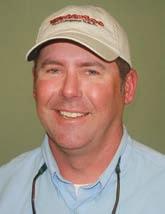
Mid bay Reds & Jacks
Phone 4 09-256-7937
Email captsteve@hillmanguideservice.com
Web w ww.hillmanguideservice.com
 View The Video Open Camera and hover over QR Code. When link appears at top of screen tap to open in YouTube.
View The Video Open Camera and hover over QR Code. When link appears at top of screen tap to open in YouTube.
CONTACT
Steve Hillman is a full-time fishing guide on his home waters of Galveston Bay. Steve fishes the entire Galveston Bay Complex, wading and drifting for trout, redfish, and flounder using artificial lures.
Dutch Duckett and Frank Mistretta took full advantage of perfect tide and winds on this day!
14 | July 2023
Steve Hamilton tricked this solid trout in a Slammin’ Chicken Bass Assassin while casting to submerged structure.

 STORY BY KEVIN COCHRAN
STORY BY KEVIN COCHRAN
Collective Intelligence
Collective intelligence plays various roles in different types of animal groups. A scientific study on bees revealed one example of the way in which the intelligence of the whole supersedes the lack of intelligence of any individual member. The study, conducted on an isolated island, shed light on how a swarm of bees selected a site for a new home.

The 12,000-member swarm had outgrown the home originally built for them by the scientists conducting the study. Predictably, once the dwelling became over-crowded, the swarm began looking for a new home. The way in which the bees conducted the search proved fascinating and revealed some surprising skills among the members of the swarm.
To test the intelligence and skills of the bees, the scientists monitoring them created two new potential nest sites and placed them the same distance away from the original home, in opposite directions. One of the new homes (marked yellow) had an opening large enough for the bees to comfortably enter, but small enough to prevent predators from invading. The other home (marked blue) was identical, except it had a larger entrance, which would allow predators to easily invade. The scientists wondered if the bees would select the better site, and if so, how they would go about doing so.
Predictably, the scientists observed scout bees making forays to all parts of the island. Eventually, some of the scouts found each of the two potential new home sites. Observers captured and marked the bees seen at the two sites with different colors, so their behaviors back at the original site could be observed and identified. Remarkably, the scouts returned to the main group and began doing “dances” which apparently indicated the direction in which they’d found something stimulating enough to motivate them to shake their tails.
These dances have been for some time recognized as a kind of language among bees. Both groups of scouts apparently used the dances to communicate their excitement about what they’d found to the other bees in the group. Importantly, the bees which had found the ideal new home site danced for longer periods of time than those which had found the “fixer-up” with the larger, more dangerous front door. Additionally, bees which had discovered the optimal site began to block, or disrupt, the dances of those which had found the inferior one.
Eventually, apparently persuaded by the scouts and their dancing, other bees began to make forays to the sites, with more of them heading to the ideal one than to the lesser one. Over time, the entire colony relocated to the better site. This led the scientists doing the study to conclude the following: while no individual bee within the group possessed the intelligence or capability to deduce which home site would be the best one, the colony as a whole succeeded in doing so.
Scientists recognize this swarm (or collective) intelligence in many species, including insects and mammals. Ants, for instance, possess abilities similar to the ones observed in the studied bees; they use scent signals passed from workers to others to communicate the whereabouts and abundance of food sources located within their range. These scent signals, like the dances of the bees, act as a kind of language.
This kind of communication is simple, when viewed as a language; it’s direct and unsophisticated on a one-to-one level, but also capable of allowing the group to accomplish goals without
comprehending how they’re doing so. Studies like the one done on the bees which needed to find a new home suggest creatures like insects and fish can communicate relatively complicated, important messages, though they possess no complex language like the ones used by human beings.
Because ants and bees can and do communicate messages within their groups using what might loosely be labeled as languages which lie beyond human comprehension, some people believe fish can do the same. This leads folks to surmise something about the behavior of fish responding to the stress of being caught, handled and released. The theory suggests the fish might move about in patterns or emit some kind of scent after their release which would indicate the presence of danger in their midst.
My own related experiences and observations would suggest such an assertion is false. For example, anglers targeting dolphin in offshore waters often leave a hooked fish in the water while casting at its schoolmates circling under the boat. In such a context, the struggle of the hooked fish wriggling against the weight of the rod and reel appears to elevate the likelihood of the others taking a bite. I believe I’ve witnessed a similar phenomenon while wading with customers and friends in the bay.
On many occasions, after a long lull between bites, one member of the group earns a strike and begins fighting a fish. Before the first fish comes to hand, one or more of the other members of the group hooks a fish, or at least gets a bite. Despite the distance between the first fish and the other(s), the hooked one’s struggle against the angler’s weight apparently sends a message which elevates the appetites of other fish which perceive the sounds and vibrations.
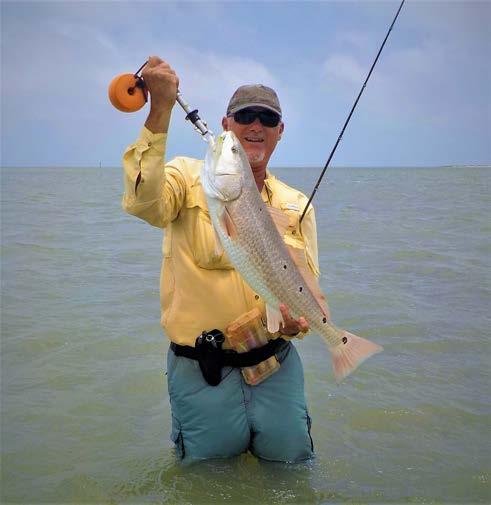
Still other aspects of these situations confound people trying to draw conclusions about the ways fish might communicate with each other in schools, and whether they show any ability to read danger from their observations of others around them being hooked and caught. Many of us have witnessed various kinds of fish changing their willingness to strike a particular type of lure on a given day. I personally have seen it with perch in freshwater lakes and schooling
 Overall, soft plastics prove more effective than other lures during the heat of summer.
Overall, soft plastics prove more effective than other lures during the heat of summer.
18 | July 2023
When fishing for mature trout in summer, anglers often catch oversized reds, like the one the captain holds here.

dolphin on the open Gulf. In both cases, I cast lures at fish I could see, originally witnessing their willingness to strike with a seemingly reckless appetite.
Over time, though, and after I pulled a few members from the school, the fish became completely unwilling to strike the once-effective offering. When this happened, they started to swim up to it before turning away without striking, eventually ignoring it altogether when it passed through the school. In those cases, switching to a different lure caused the cycle to repeat. I’d catch a couple more fish on the new shiny thing, then the fish would refuse it. Eventually, in the case involving the mahi mahi, I resorted to tipping a jig with fresh dead bait. Once they tasted something real, the schoolie dolphins wouldn’t touch a naked lure again.
Someone observing those behaviors might conclude the fish have correctly deduced a dangler related to biting at a particular type of lure, and learned to avoid doing so, after seeing their schoolmates which struck the lure hoisted out of the water. Such a conclusion runs counter to the ones related to observations of fish becoming more likely to strike something when they perceive the struggles of their hooked schoolmates. From all this, I draw a relatively simple conclusion, one related to the nature of the way the brains of fish work.
Unlike organisms with more developed brains, fish don’t make decisions using judgments based on their cognitive abilities. They simply react or don’t react to stimuli, depending on more basic brain functions. Their behaviors more closely resemble reflex reactions than calculated decisions.
Consistently, all the evidence related to swarm (school) intelligence supports the same claim with respect to the intelligence levels of individual members of these animal groups. Individually, they possess almost no recognizable level of intelligence, as defined by the ability to make reasoned judgments, using cognitive skills. The group dynamic, created over time, through thousands of simple messages being sent and received, generates a higher level of intelligence for the group, one which far exceeds the capabilities of any individual member.

I recognize several ways in which these concepts apply to my favorite fish. People often claim speckled trout change their habits and relocate in response to increasing boat traffic in an area. Certainly, in the short term, this does occur. Enough boats running down a shoreline will drive a school of fish into deeper water because of the accumulated responses of individual fish to the negative stimuli. In the end, this could create a lasting response from the collective, if the boat traffic in the area remains high enough over time.
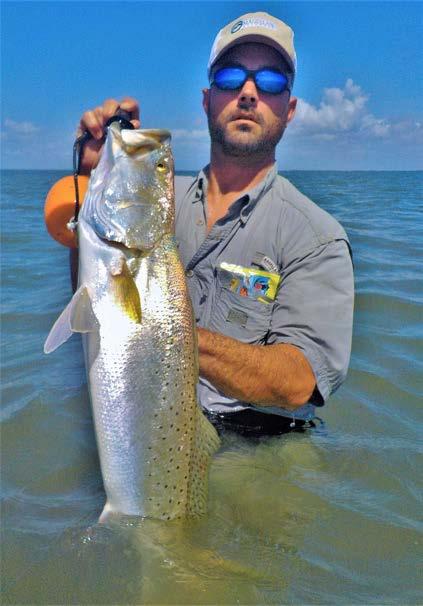

However, this reaction doesn’t indicate anything significant about the intelligence level of individuals within the school, nor about the ability of any of the fish in the school to make decisions based upon the power of reason. The fish don’t flee from the noise of the passing boats because they realize the commotion represents danger in the form of human presence. Postulating that the fish in a bay have abandoned the shorelines over the long term because they realize humans are present and trying to catch them is fantastic thinking.
KEVIN COCHRAN
 The Captain describes the importance of size and scale in the process of data analysis.
The Captain describes the importance of size and scale in the process of data analysis.
CONTACT
kevincochran404@yahoo.com Web www.captainkevblogs.com T ROUT TRACKER GUIDE SERVICE
View The Video Open Camera and hover over QR Code. When link appears at top of screen tap to open in YouTube.
Phone 361-688-3714 Email
Kevin Cochran is a long-time fishing guide at Corpus Christi (Padre Island), TX. Kevin is a speckled trout fanatic and has created several books and dvds on the subject. Kevin’s home waters stretch from Corpus Christi Bay to the Land Cut.
Chip Colvill caught this pretty trout on a soft plastic on a hot summer day.
20 | July 2023
Alton Morris threw his soft plastic close to a visible rock lying in a grassy meadow in Baffin Bay to catch this trout during the month of July.


TSFMAG.com | 21 Do you love offshore fishing in the Gulf of Mexico? Learn to improve survival of released reef fish through our 15-minute training and receive $100 worth of fish release gear for FREE. GET FREE GEAR. BE A RESPONSIBLE ANGLER. HELP REEF FISH SURVIVE RELEASE. Join the community at ReturnEmR ight.org.
Extra effort is encouraged when releasing redfish back into warm marsh water after a prolonged fight.
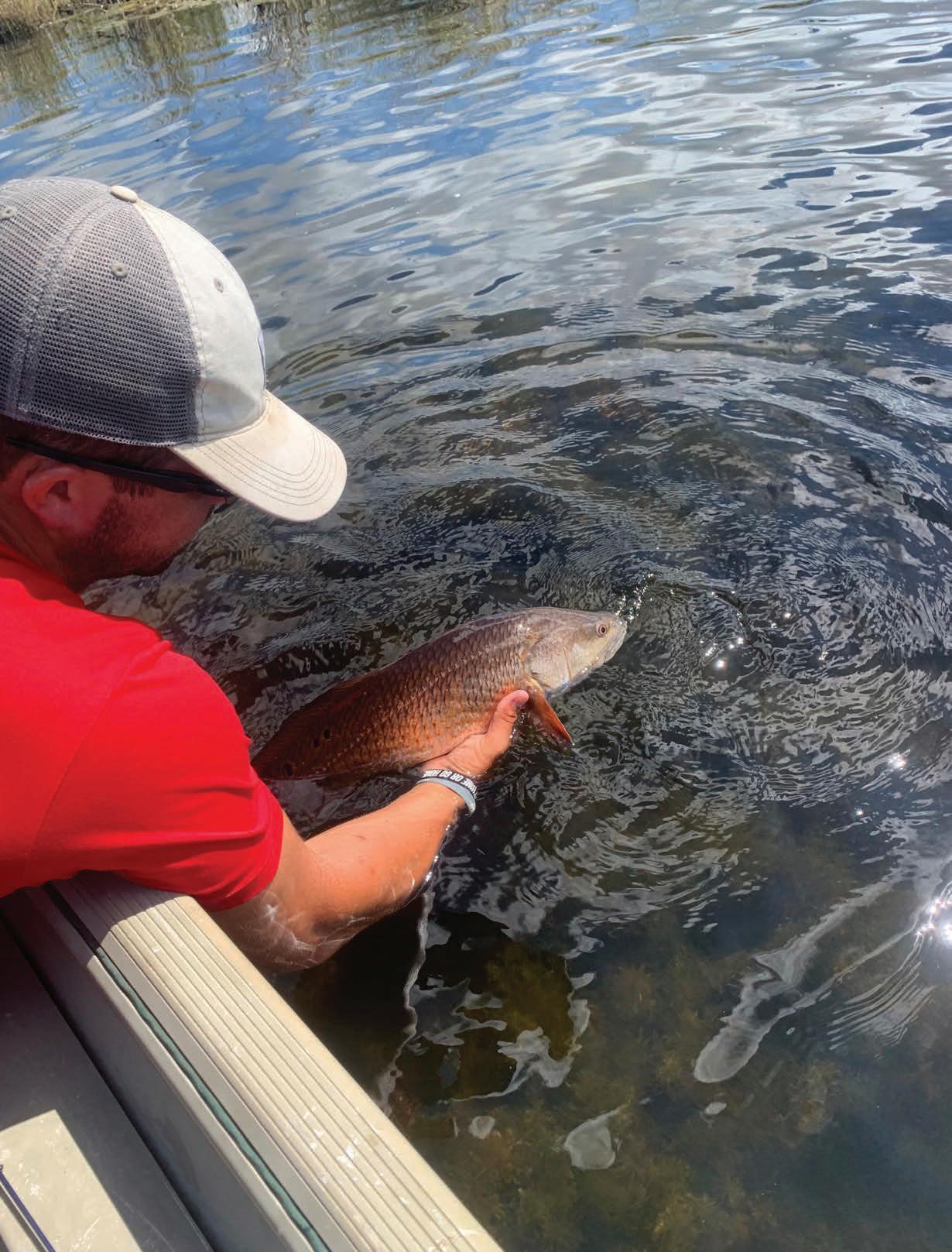
WarmWeather, Kids , &
Great Fishing!
STORY BY CHUCK UZZLE
If you spend your fair share of time along the Texas coast you already know July means several things, and on top of the list is warm weather. Texas summers are notorious for sweltering temps and breathlessly still days that often times start off near 90° before the crack of dawn. Fishermen will need to employ some different strategies this month in order to remain successful and comfortable.
There was an AM radio station, KOGT here in my hometown of Orange, that for years ran a program called Let’s Go Fishing and they gave reports for Sabine Lake, Toledo Bend, and Sam Rayburn. The host, Richard Corder, had a saying, “If it’s 80 before 8:00am you know it’s gonna be a hot one.” I often think about those words each morning when I check the weather before heading to the launch and realize how right Richard was, especially when the calendar is flipped to July. Those ultra-still and sticky mornings require a little more preparation than normal, especially when you have folks in the boat who may not be properly acclimated to these types of conditions. Special precautions need to be taken each time you leave the launch during summer because suffering a heat stroke or any other heat related illness is a real problem that can happen in the blink of an eye if you aren’t careful.
Obviously, the early morning and late evening bite is the most comfortable and two of the most popular programs in town. Plenty of anglers will trade a few extra hours of sleep to enjoy the comfort that’s provided when the sun is going down. I normally don’t run much in the dark but, when I do, you can bet one of the top places I’ll look at first will be the jetties. If you’ve never been fortunate enough to get in on the pre-dawn topwater bite at the rocks you are missing out because there’s not much like it when it’s right. I have said forever that the trout that hang out at the jetties are a different breed, for
some reason they seem to be so much more aggressive and just wired up like 440 volts. If you make one quality trip down there and get into those fish before the sun comes up I promise you will figure out a way to do it again.
Despite the warm temperatures, July tends to be much more predictable as far as weather is concerned, especially when it comes to wind. Quite often there isn’t even a breeze to be found and the absence of wind can be both a blessing and a curse. On the one hand you get very little relief from the heat, while on the other hand it makes finding fish so much easier. During the summer months, both Sabine and Calcasieu will have some solid fishing under flocks of birds. The gulls and terns will be shadowing both speckled trout and redfish while they gorge on brown shrimp that are making their way out of the marshes and into the main body of the lakes. Those flat calm days make it so much easier to keep up with the schools of fish as they move because you can not only see where they are going but you can hear them as they crush their meals along the surface of the water. That tell-tale “slurp” has been a welcome sound to fishermen forever as they try to chase down those fish that are herding up the shrimp.
Many times, after the birds leave a school of fish you can sit in that area and wait until the fish get cranked up again. All it takes is one trout to eat a shrimp from the surface to give away the location of the whole school and suddenly everything starts all over again. When this happens it’s especially productive because the birds have usually gone looking for another easy meal, which means there is nothing to attract another boat to your location. Having a hungry school of fish all to yourself is a joy unlike no other.
Just like many other things there are two sides to every story. So where one story makes things good it also makes other things tough. The calm seas will be a welcome sight for the folks who
TSFMAG.com | 23
patrol the big water like the beachfront, the nearshore oil and gas platforms, and beyond. The flat calm days will allow the water to settle out and provide some of the best clarity we will see all year. It’s much easier to turn your nose up at catching trout under the birds when you can run the gulf and go after species such as snapper, tripletail, and others that will give you a bona fide full pull.
Like I mentioned earlier there is also a bad side to the elevated temperatures and slight winds, and that’s the negative impact that the shallow water guys will sometimes experience. The backwater marshes and ponds will get super-heated during this time of the year and this can make the redfish we’re chasing very lethargic. The elevated temps will do a number on the grass and other vegetation, which in turn reduce oxygen levels in these shallow water areas, making catching those fish much tougher than normal. If and when you do manage to catch redfish in that warm water, take extra care when releasing them as it takes quite a bit longer to revive them after a fight. Make sure those fish swim off healthy and don’t go belly up after a few yards; you owe it to them to make every effort to completely revive them before releasing.


July will provide us ample opportunity to pursue a variety of angling scenarios, which is an absolutely perfect time to get the kids involved. Like I mentioned before, please take proper precautions to deal with the heat. Bring the obvious necessities such as plenty of cold drinking water, sunscreen, a wide-brimmed hat, or some other type of shade. Keep your trips to a minimum and don’t force the kids to stay if they are not comfortable or having fun. Remember that it’s their trip too. Do whatever you can to avoid having them less than anxious to go next time. Carry some bait, live or dead, so they can increase their odds of catching something.

View The Video
Summertime Adjustments
Remember
CHUCK UZZLE
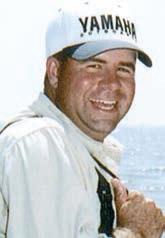
Phone 409-697-6111
Email wakesndrakes@yahoo.com
Website wakesndrakes.com

CONTACT
kids just want to feel the pull and the species doesn’t matter, which is exactly as it should be.
Chuck fishes Sabine and Calcasieu Lakes from his home in Orange, TX. His specialties are light tackle and fly fishing for trout, reds, and flounder.
Open Camera and hover over QR Code. When link appears at top of screen tap to open in YouTube.
Summer is perfect for taking kids fishing. I took Hope Prejean, Marren Crawford, Gracie Burch, Brylee Burtsfield, and Brie Thibodeaux for a birthday trip that included a stop for a swim.
Speckled trout stomach contents reveal a shrimp-heavy diet this month.
24 | July 2023
Chance Hobbs shows off a quality Sabine Lake speck taken near the jetties.

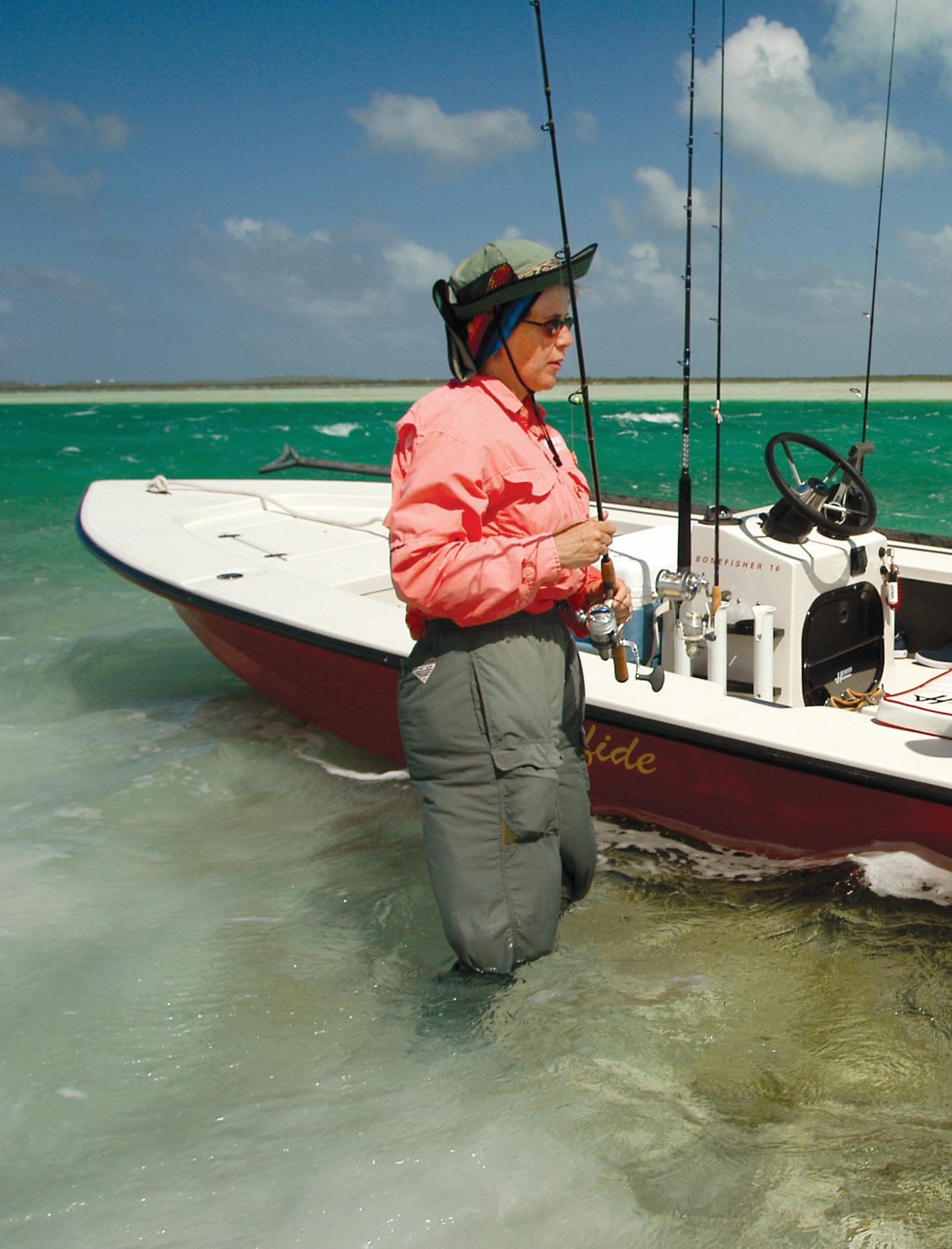 Amy on a windy day with Capt. Docky Smith at Long Island, Bahamas.
Amy on a windy day with Capt. Docky Smith at Long Island, Bahamas.
Coastal Fishing Guides
 STORY BY JOE RICHARD
STORY BY JOE RICHARD
I’ve been watching old episodes of Andy Rooney on 60 Minutes lately, which inspired the following missive on the surge of fishing guides in recent years.
Ever notice how many fishing guides are out there?
Lots of people starting out in the business these days, and some of them young. My local tackle store owner seemed disturbed the other day, after a young woman who “looked 17 years old” told him she was the best guide around. We agreed her hours on the Gulf might have been pretty low. Who knows, maybe she was raised on the coast and her dad was a shrimper or guide.
Today’s young guides start out with some awfully nice boats, compared with 30-40 years ago, and might not consider that their banks expect monthly payments, no matter how the weather and fishing has been. And don’t forget that boat insurance policy.
Years ago, most guide boats on the bay were pretty basic; many were smaller, slower, way cheaper and designed to make a living. Often, with a sponsored outboard motor. Those programs still survive today, though the competition must be tough. Guide boats range from small skiffs meant for poling and fly fishing with a single client, up to the big offshore boats hauling six clients.

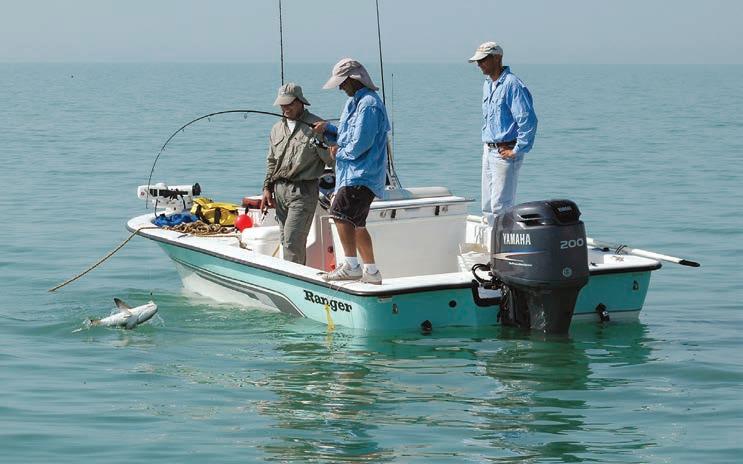
Fishing guides come from a real cross section of society. Years ago we had only a handful in Port O’Connor, including one who commuted from Palacios. There was a retired tow truck driver, a former dance instructor, a failed banker, a former highway patrolman, and a retired county extension agent who collected used boats. Some of them auctioned off for a dollar, after he retired.

Our oldest guide, neighbor Capt. Lee Richter, flew B-26 bombers in WWII (featured on the History channel, available on YouTube). He was still guiding in his 80s, though he also ran a small outboard repair shop and wasn’t out in the sun every day. In later life he fished the jetties strictly at night, often returning to the boat slip with a pretty good bump, though his 24-foot Aquasport could handle it.
Long-term guiding is a fairly hazardous business. I’ve been around a few guides and have seen Texas weather and whitecaps wear them down. Their health deteriorates, though that happens to everyone. I haven’t kept up with all those I fished with, but a favorite Port Mansfield guide developed painful sciatica in his leg and had to retire early. Standing all day in the boat in that shallow, windy region, year after year. He wasn’t driving a big boat, either.
Another favorite, Captain Howard Horton in Galveston, had three fingers bitten almost clean off by a gaffed and agitated three-foot blacktip shark. Howard spent a few days in the hospital after his fingers were reattached. He fished barefoot and one day had a 30-pound mahi ram a billfish hook through the top of his ankle. His teenage son Mike (now a captain) got smacked in the face by a sailfish bill in Cozumel. The local doctor did such a crude job stitching Mike’s face, his friends nicknamed him Monster. Everyone can use a nickname, but that’s going a bit far. I haven’t seen Mike in years but suspect he’s doing well offshore after countless “trips,” as the guides call them.
As I write this, after guiding on and off since 1994, I’ve been “paying the butcher’s bill” after so many years in the sun. I currently have 10 stitches on my head and eight across the bridge of my nose, handiwork of a skin doctor.
Typical charterboat in blue water off Islamorada in the Florida Keys.
Capt. Mark Cowart’s boat off Flamingo in far South Florida.
28 | July 2023
Cajun guide boat off Venice, Louisiana.

We see each other fairly often and my lifetime stitch total, dormant for decades despite lots of fishing, increased eightfold in the past 10 years. It’s impossible for a guide to escape the sun, because fishing only on rainy days doesn’t work. I’ve been sunburned even on foggy days. I started wearing a cap with earflaps in 1983. When it blew overboard during a three-day tournament, I wrapped my head with spare cloth like a Berber. In the past 30 years it’s been long sleeve guide shirts, long pants, and half a dozen brands of gloves before settling on Fish Monkey. The best sunscreen we’ve found is Neutrogena 50 with lots of zinc oxide. I wore a red bandana, good for photography, before Buff masks ever reached Texas. When I wore it in Venezuela people grinned, raised a fist and shouted, Chavista!
There are lots of ways for a guide to get hurt in this business. Like getting poked by a hardhead catfish while (wisely) unhooking these semi-poisonous fish for clients. I’ve unhooked plenty of hardheads over the years, but haven’t been stuck in three decades. Getting rid of stingrays is another problem and so far, no hits. (I cut the leader to avoid that poisonous tail).
I seldom wade fish except in the surf; many of our years were instead spent boating out to the jetties, anchoring and then walking the rocks, flirting with another trip to the ER. Wading guides see plenty of other hazards, including death-dealing Vibrio bacteria, stingrays, sharks, jellyfish and cruel oysters. On the jetties, the biggest hazard is falling. There was also the problem of swimming back to the boat anchored close by at sunset, after sharks had been tugging on our heavy stringers of trout.
And we’ve certainly seen our share of sharks but so far, no damage. Just a little chomp from a needle-toothed, sand shark that wouldn’t let go of my finger until Amy pried it loose with an oyster shell. (One more reason to carry needlenose pliers). I did have a Keys guide grab a lemon shark too far back, and it whipped around quick as a snake, grabbing his entire hand. We pried the shark loose and the guide, with a dark tan, turned lily white and sank to the deck. He was revived with three Cokes and a towel soaked in ice water across his face. We came back early, that day.
Fishing guides accrue their own stories of freakish injuries and adventures. We’ve all had lightning strikes close by, with differing results. One guide wisely took shelter on one of the marsh cabins off Port O’Connor: lightning was everywhere and the wind was bad. His clients soon relieved themselves off the covered dock. When the guide did so, lightning struck a small mangrove bush only feet away and the shock traveled…up his urine stream. He said it was like being punched below the belt. No doubt it was bright and deafening, too. Only a mile away at Clark’s Marina, different day, a guy at the cleaning table had his electric knife knocked out of his hand and across the side of his neck, because someone carelessly threw a trout carcass and hit that dangling electric cord.
There are stories of weird and freakish misfortune on the water,
and a guide’s job is to make sure none of these things happen. Customers expect a routine and hopefully productive trip, although I’ve had clients ready to fish who said they needed excitement in their lives, because they were “empty nesters.” There is a lot more excitement out there, than they bargained on.
It’s tougher to be a guide these days, in some respects. Boats are faster, but way more expensive, along with gas prices, and thank goodness for those fuel-efficient, 4-stroke outboards. Onboard electronics are way better, and weather forecasting (with current cellphone radar) so much better. Boats are bigger, safer and outboard motors more reliable. But competition is fierce from other guides. And the fishing public has grown, with many more boats on the water. (There was a boat-buying frenzy in 2020). Meanwhile, not one new acre of coastal water has been created to fish. Most oil rigs offshore, easy to see and tie up to for decades, have been removed.
So, my hat is off to these new fishing guides. May their new careers by safe and productive.
CONTACT
JOE RICHARD
Joe Richard has fished the Gulf since 1967, starting out of Port Arthur, but his adventures have taken him up and down the entire coast. He was the editor of Tide magazine for eight years, and later Florida Sportsman’s book and assistant magazine editor. He began guiding out of Port O’Connor in 1994. His specialty is big kingfish, and his latest book is The Kingfish Bible, New Revelations. Available at Seafavorites.com
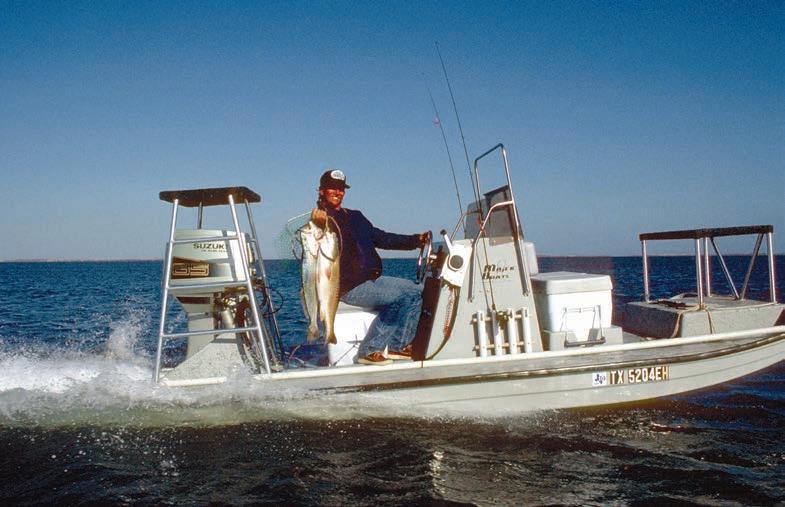
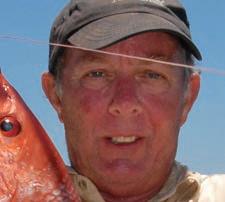
30 | July 2023
Capt. Steve Ellis returning to South Padre Island around 1987.

Tourney Recap
Tons of preparation and planning goes into even the smallest of fishing tournaments so you can imagine what kind of horsepower it takes to organize, prepare, and execute one of the largest ones on the Texas Coast. This year Shallow Sport/SCB Boat Owners Tournament had just over 250 registered teams totaling over 1000 anglers. Just days before the event South Padre encountered some extreme weather causing extensive damage to the convention center where the venue for this big tournament was to be held. With dedication and commitment from Shallow Sport staff and SPI officials they were able to put a bandage on the damage and we were all set. The highly anticipated “shotgun” start was on everyone’s minds, but Mother Nature had something else in store for the take-off.
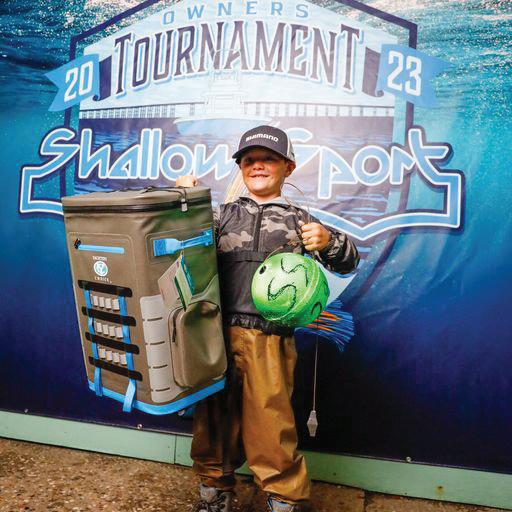
At the eleventh hour, based on a multitude of weather forecasts, Shallow Sport President, Wes Hudson made the call to remove the historic shotgun start from the equation and left it up to the anglers to engage in safe fishing at their discretion. Early Saturday morning boats started to trickle out despite lighting and thunderous


32 | July 2023
conditions throughout the bay system. Water levels rose and winds cranked to the likes of which I’ve not seen often. Fishing was tough and our team struggled to get any fish to eat as they were days before, prior to the severe storms rolling in. We were on em; we saw em but just couldn’t get those heavy reds to eat. With all that said, while searching for trout we had a few take tops to include a solid eight pounder as noted in the photo. Not too shabby and this in and of itself made the day worth it. We had another oversized trout that couldn’t be weighed, and we only managed one “legal” trout that put us in 5th place for that category. Additionally, there were just over 100 boats who weighed in fish and thanks to the new incentive program for weighing in live fish we successfully released just under 60 back to the bay to fight another day, now that is awesome.
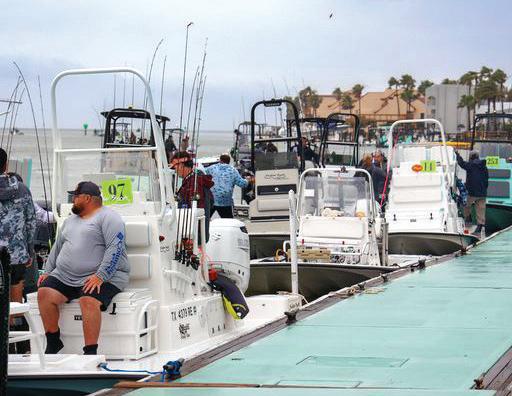
The weather didn’t back down whatsoever all day and winds only increased in strength, we stayed wet all day and quite chilly to be honest. Throughout the day controversy and critique started making its way through social media, some of which was discerning to say the least. So, what was the right call for Shallow Sport to do? Was there a right call? Some say the right call was made while others say they should have cancelled the event. Who’s to say what’s the right or wrong call - in my opinion the wrong call wasn’t made. There were zero injuries or incidents on the water and anglers who participated had a challenging but great day on the water. For those who elected not to fish, well, they still had one heck of a time at the awards ceremony/event, and someone walked away with an $80,000 Shallow Sport Boat.
Till next year…
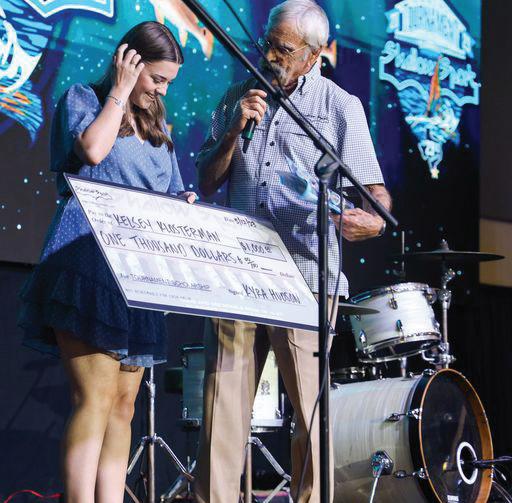
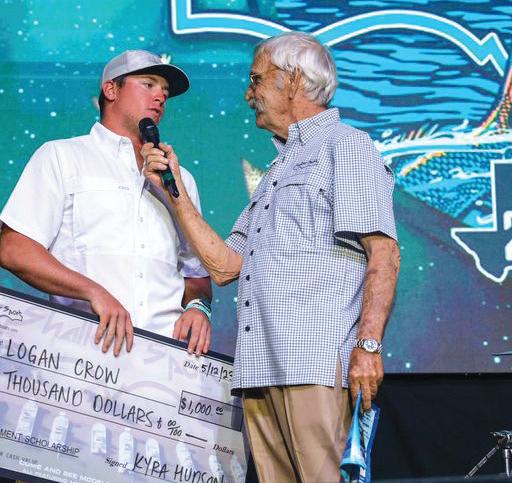


TSFMAG.com | 33
STORY BY CHRIS MCKINLEY
Editor’s Note and Introduction: I had the pleasure of meeting Chris McKinley during the Houston Fishing Show this past March. He introduced me to a program he was launching that he has dubbed; Trout Tagging Texas. Naturally, with spotted seatrout fisheries management right at the top of my own conservation agenda, my interest was piqued immediately. I promised to follow the launch of Chris’ efforts and, hopefully, lend the support of this publication to assist its growth.
While I am fully supportive of Texas Parks and Wildlife Department’s efforts in managing this popular fishery, and believe they have done an excellent job, I have long encouraged that anglers practice conservation above and beyond daily bag limits, etc., to help insure the sustainability of the resource through self-imposed practices, such as catch and release. And not just trophy-class fish, but all sizes, especially the vitally important mid-slot spawning age females.
It will be very interesting to learn how Trout Tagging Texas is received by the fishing community, especially the impact on individual anglers lucky enough to land one of the tagged specimens. Yes, the growth data of tagged specimens could prove be of value to fisheries managers, and certainly how far and what direction the recaptured fish may have roamed after tagging. But, in my view, there’s an aspect of even greater value.
Landing a tagged fish could be a tipping point for anglers who question whether catch and release is a valid strategy toward achieving future sustainability of the fishery. The proof will be in their hands!
So, I say mega-conservation kudos to Chris McKinley and all the fishing guides and private anglers who have joined his tagging team...Keep up the good work! And to the lucky anglers who land one of their tagged fish…please record the tag number, measure it, report the recapture, and then let it go!
Cynoscion Nebulosus (A.K.A. speckled trout) is what we at Trout Tagging Texas are all about. We are dedicated to tracking growth rates, migration patterns, and the population of speckled trout, along all the bays of the Texas coast.

Not very long ago, Texas fishermen began noticing a decline in the numbers of speckled trout, and especially the upper-size class of fish in our bays. Although our fishing success has been growing tougher on average, we are still having those days where we can catch them really good. And so it crossed my mind one day; “How many times has this fish been caught?”
By tagging and releasing these fish, we will be able to monitor how often a fish might be recaptured, by giving each tag an individual identification number and a phone number to report the information. With that, we will be able to track how much the fish has grown, and moved since being tagged, by entering the information provided by anglers into our database.
Our plan is to use color-coded tags to better track movement. Orange tags for Upper Coast, yellow tags on Middle Coast, and green tags for Lower Coast fish. Fish captured in the surf will receive red tags.


34 | July 2023
Our initial plan was to target fish of at least 20-inches. However, we have since revised that to any fish longer than 15-inches. The original thought was that upper-class trout needed more protection to continue their spawning activities. But with the current “emergency regulations” of three per day between 17- to 23-inches enacted after the Freeze of 2021 along the Middle and Lower coasts scheduled to expire at the end of August 2023, we decided to make the change. Beginning in June, we began tagging any trout of 15-inches and greater length.
The reasoning in this is very basic: We want to encourage anglers to release legal length trout, not toss them in an ice chest simply because it’s legal.
When catching one of these tagged fish, it is highly encouraged to report the information to the number provided on the tag, along with a few quick photos. As an incentive; anglers who provide a video of a tagged fish being released will be rewarded with a $25 gift card and swag bag donated by Waterloo Rod Company, along with lures from Speckled Truth and Coastal Swimbaits.
We have teamed with some really great fishermen and outfitters along the coast, and with their help, we have now tagged and released more than 200 fish, with more being reported weekly from bay systems all along the coast. It is very exciting to receive news of tagged fish being recaptured, a total of three since the program began, which fishery biologists say is an excellent recapture percentage this early in the program. Of note thus far in our recapture data; one fish travelled 25 miles from bay to surf near Matagorda, and another grew nearly half an inch in less than three months.
With summer weather patterns developing and more anglers on the water, we are hopeful to see more recaptures being reported. Please remember that our mission is to spread the awareness that catch and release practiced in even greater measure can be a viable tool toward improving our speckled trout resource. Let’s all do our part and make it better for anglers to enjoy for generations to come.



Thank You for taking the time to read about our program and we ask everyone to think back on how awesome the trout fishery used to be. Practicing more conservative methods on the water can help bring it back.
 Chris McKinley – Trout Tagging Texas – Chris@trouttaggingtexas.org
Chris McKinley – Trout Tagging Texas – Chris@trouttaggingtexas.org

TSFMAG.com | 35
JAY WATKINS ASK THE PRO
SETTING THEM UP FOR SUCCESS
In this month’s article we are going to discuss the importance of providing your spouse with the best tackle and fishing attire you can afford when introducing them to fishing. All the content in this article can also be applied when introducing your children, and others under your care, to fishing. Providing the right tools for the right game are a must if you want them to enjoy the sport. I also want to express to you the importance of stepping out of the husband/dad role and stepping into the coaching role. The greatest coaches all have one thing in common; they unselfishly want the player to succeed and become the best they can be.

Most know by now that I am a minimalist. I like to wade and travel light in every aspect of the game. I don’t wear bulky clothing or heavy wading boots. I use lightweight rods and reels and carry no landing net. I wear a minimal style of wading belt that holds my pliers and Boga Grip, and I don’t always carry a Boga. I carry very few lures, keeping them in a small box that is stuffed between the wading belt and wading pants or waders. Granted, I have a good idea of what I will be needing for the wade, due to the amount of time I spend on the water each week.
Featured here will be four ladies that I have the good fortune to fish with on a regular basis. What they have in common are spouses that have a great passion for fishing and enjoy sharing days on the water with them. They also provide the best equipment for the ladies to use. My wife, Renee, uses the exact same of everything that I use. Yes, I had to teach her how to use it and become comfortable in the water with me. It is natural that ladies suffer from fear of things that go bump on the bottom, and I get it. There are several products on the market that help prevent bad stingray encounters. If you or they are worried, then take precautions and get them protection. For the record, and if you are wondering, I do not wear stingray protection. And yes, I have been hit. Stupid is as stupid does, I guess. So, with all this said, I want to showcase some of my clients that have taken my advice, and the advice of others, and provided their wives with the best of the best.
I will begin with my wife, Renee. First, she is very athletic and has great eye-hand coordination. She is extremely competitive and wants to do well at whatever it is she is doing. She competed in co-ed softball until she was 45. Played shortstop and fielded plenty of heat from the guys in the league, and could promptly throw them out at first. She’s a badass, no doubt. This same drive has made her the success that she is today in the business world.
Coordination helps immensely in casting, lure presentation, and also fighting fish. Lucky for Renee, I have the best of the best in saltwater sponsorships, so providing her with the best tackle was a given. I have told a bunch of people that Renee was quick to pick up on casting a baitcasting reel and just as quick in learning lure presentation. Funny thing was, I would say twitch the lure three or four times and then pause. Her comment was always, “well is it three or four?” I would secretly laugh inside knowing that her response was just her wanting to know exactly how many times to twitch the rod tip. In her world, the medical field, everything is black and white. Fishing is “greyer” I told her.
She took coaching well and success came quickly to her. My proudest moments were on tournament days when we got to stand in the winner’s circle together. Little did she know just how proud I was of her, and that her wanting to fish with me meant the whole world to me. It is simpler today when we fish, which is honestly not often due to life just getting in the way, she wants to throw exactly what I throw in
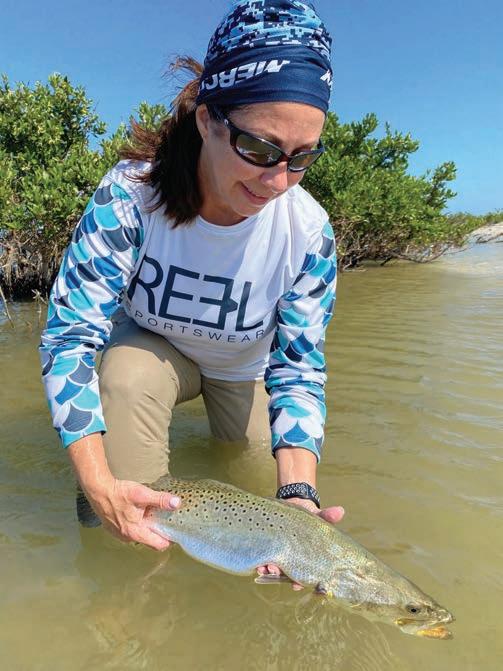
36 | July 2023
Renee Watkins





CUT HERE AND MAIL F R I D A Y , A U G U S T 1 1 , 2 0 2 3 | 6 : 0 0 P M Bauer Community Center 2300 TX-35 | Port Lavaca, TX 77979 6TH
PORT LAVACA $ 1 , 0 0 0 B U L L R E D T A B L E ReservedSeatingfor8,Tablegifts,Fullpage adinprogram $ 7 5 0 T R O U T T A B L E ReservedSeatingfor8,Tablegift,Businesscardadinprogram $ 5 0 0 F L O U N D E R T A B L E ReservedSeatingfor8andProgrammention $ 6 0 I N D I V I D U A L T I C K E T $ 3 5 Y O U T H T I C K E T ( 6 - 1 7 ) Join us for a night ofdinner cateredby Cathy's, drinks, auctions, Sportsman's Raffle and goodoldfundraising fun! $1,000 Bull Red Table $750 Trout Table $500 Flounder Table $60 Individual Ticket $35 Youth Ticket Qty. Qty. Qty. Qty. Qty. Price Price Price _ Price Price Table Name__________ Total Amount Name Email Address Phone Credit Card_______ CVC Exp. Date Signature Checks payable to Coastal Conservation Association | Mail form & money to: CCA Texas, Attn. Carson Vecera, 6919 Portwest Dr, Ste 100, Houston, TX 77024 TICKETS ALSO AVAILABLE AT www.ccatexas.org/events/2023-port-lavaca-banquet For More Information: Carson Vecera 713.626.4222 | cvecera@ccatexas.org
ANNUAL CHAPTER BANQUET
every situation. When I ask her what lure she wants to use she simply says, “the same one you’re going to throw.”
Next is Beth Bunk. Total joy to fish with and a perfect example of a wife that has a family of all guys that fish and hunt to an extreme. Beth is comfortable wading in the thigh-deep stuff, drifting in a bay boat, chasing black marlin on the Great Barrier Reef, chasing white marlin off the coast of Ocean City, Maryland, or following the families quail dogs in South Texas. Craig, her husband, has provided the entire family with the best of everything. I think they might secretly own stock in the Waterloo Pro Shop. On a recent trip Beth told me that Craig had her out on the back deck of their home the night before, casting and making final adjustments to the new reel he had purchased for her. Practicing is such a huge part of the day and just a few good casts the night before will ensure that all is in good working order.

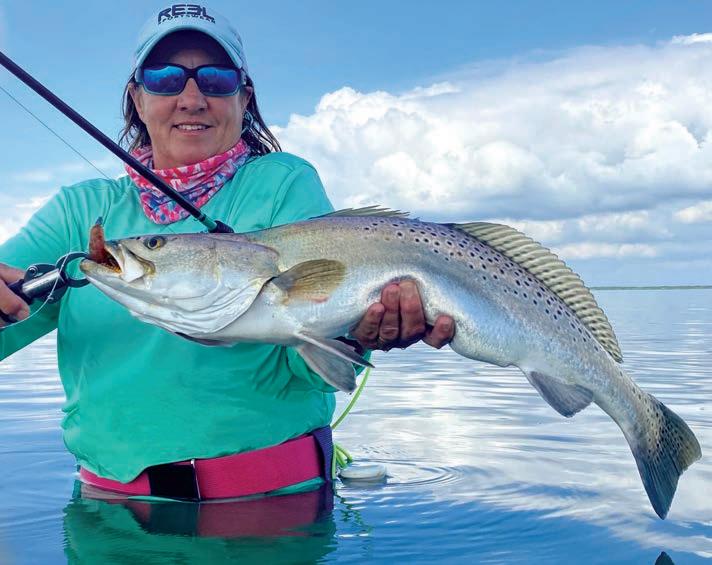

On this particular day Beth crushed it, catching limits of trout and reds while standing in between Craig and I. She possesses good casting
skills which allow her plenty of water time with her lure on each cast. She pays attention to how she works the lure and knows the difference between a bite and bottom grass. In our clear water the ability to make long casts is an absolute must, in my opinion. Beth, like all the ladies in this article, can cast extremely well, and that alone aids in her success. This cannot be achieved without the proper rod, reel and line setup, and some good old-fashioned practice. I often ask people that are having trouble casting if they have practiced and most of the time the answer is no. How could we possibly become better without practice? So, the moral to this story is simple, practice and you will see improvement.
Alyson Donaldson, what a lady and fisherman. Tough is what she is. I have never heard a negative word or an excuse from her on the many fishing trips we have been on together. Life deals us all some crappy cards at times, she’s had some of the worst, but she dusts herself off and pushes on. If I had to guess, I would say that her strength comes from her faith. This is what I respect the most about her. The way we deal with a bad hand is what defines us, it makes us what we are. Alyson, like all the other girls is an avid outdoorsman. She hunts deer, dove, quail, and turkey on her family ranch. She is a student of the game. She too has been provided with the best equipment and she practices from the dock of her second home in Key Allegro. Alyson fishes a lot with her husband, Drew, so she gets plenty of practice. In the beginning of our fishing together she would watch me cast and work my lure, trying to mimic the motion and action. This is an excellent way to learn but one must be smart enough to know this and not be intimidated by admitting that they need instruction. Alyson has excellent casting skill and a lure presentation technique all her own, a skillset I have often caught myself watching. Just today, she caught her personal best trout with me; a fish just over 6 ¾ pounds. Do you know how huge it is for a guide to become part of an unforgettable moment? As I waded toward her with a few suggestions on handling such a fish, Drew watched silently. He was beaming as she pulled the fish to hand and snapped
Lisa Laskowski
Alyson Donaldson
38 | July 2023
Beth Bunk
her Boga in its lip. A few quick photos, a video of the release, and then a quiet moment to take it all in.
Last, but for sure not least; Lisa Laskowski. Total badass with a rod and reel and she too has the support of her husband, Big Mike. Mike’s big, real big, hence the name. I love this couple and their children, Michael and Lindsey. Lisa’s had some tough hands dealt her as well, but she just goes on. True Grit is what this girl has. All of the family are excellent anglers and spend a ton of time on the water. They are also avid hunters, spending lots of time afield on the family farm for whatever is in season, and whatever you can make into sausage or throw on the BBQ pit.
Lisa and I bonded on the very first fishing trip we went on some twenty years ago. I extended my hand to her as she slipped while fighting some heavy mud that her guide had waded her into. She was teary eyed from embarrassment, sunscreen in her eyes she said, but we laughed and trudged on. That moment broke the ice. I ceased being her guide; I was now just a guy and she was just a girl, stuck in the mud. Later, during that same wade, Lisa became my very first cover photo for this magazine, posing with a super nice flounder she caught out of a drain mouth on a hard-falling afternoon tide. Lisa has tremendous angling skills and uncommon intuition of where the fish
will be. Seldom does she stay with the pack but she never pushes forward from the group. Always off to the side and usually up shallow. She is never intimidated by anything or anyone. Lisa is a big trout enthusiast and has a personal best of eight pounds. No, she did not catch that fish with me. She has caught some very nice trout with me and she photographed a 10-plus trout that I caught with she and Mike several years back. We have made many wonderful memories together and plan on making more.
I cannot stress enough the importance of providing your special someone with the best you can afford. How can we expect anyone to gain a love for something that we don’t teach them to do well? Quality of everything is a must, from what they wear, to what they use. Buy quality and buy once has always been my mindset. For instance, all the ladies mentioned throw baitcasting reels (13 Fishing, Shimano. Lew’s), quality custom-built rods (Henri, Waterloo, Sarge, Laguna), Simms waders and wading boots, Reel sportswear, Patagonia, Orvis, Smith, Costa, to name a few. Oh, and Texas Customs Jay Watkins Series fishing hats!
Jay Watkins has been a full-time fishing guide at Rockport, TX, for more than 20 years. Jay specializes in wading yearround for trout and redfish with artificial lures. Jay covers the Texas coast from San Antonio Bay to Corpus Christi Bay.

Telephone 361-729-9596
Email Jay@jaywatkins.com Website www.jaywatkins.com

CONTACT
View The Video Open Camera and hover over QR Code. When link appears at top of screen tap to open in YouTube.
TSFMAG.com | 39
By Joel Anderson, Facility Manager, Perry R. Bass Research Station FIELD NOTES
AGE & GROWTH OF COASTAL SPOTTED SEATROUT IN TEXAS
One of the main hurdles facing fishery biologists is that the subject of their science occurs under water. For this reason, fishery biologists are prone to take data points from wherever they can get them. A great example of this is the use of otoliths to determine age in fishes. Otoliths are hardened bone structures inside the head of a fish. They are analogous to inner ear structures in mammals, and perform similar sensory functions. More importantly for biologists, otoliths tend to deposit rings on a yearly basis, called “annuli”, which when examined microscopically, allow fishery biologists to determine the age of a fish accurately. Age is a very important data point, and can be related to an individual’s overall growth, mortality, reproduction, and other important biological metrics. For this reason, a significant component of the research that is conducted by the Texas Parks and Wildlife Department’s Coastal Fisheries division is focused on analysis of otoliths from various coastal finfish species.
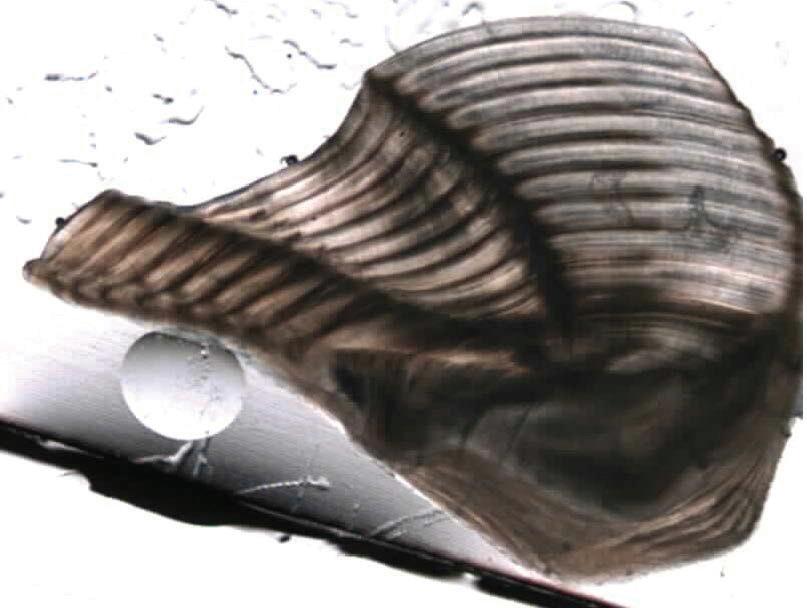
To this end, we collected otoliths from Spotted Seatrout (a.k.a. “speckled trout”) during a 20-year span between 1998 – 2018, in an effort to learn more about age structure and growth of this species across the Texas coast. Over that span, over 14,000 otoliths were collected
and analyzed, and collections were made in every bay system in Texas from the Laguna Madre to Sabine Lake. This study has yielded some interesting results and has broadened our understanding of the biology of this species in Texas.
First and foremost, when we compared body size to age in Spotted Seatrout, we found that females tended to grow faster for a given age, and obtain a larger terminal length (the size at which a typical fish stops growing in length) than males. This probably comes as no surprise to the seasoned angler in Texas, and frankly it wasn’t a surprise to our biologists either. Trophy-sized Spotted Seatrout (> 25 inches) are usually females. As it turns out, the terminal length of female trout in Texas is around 30 inches, compared to about 23 inches in males. Terminal length in both genders is approached between 8 - 10 years old. The fact that a “typical” female stops growing at about 30 inches puts the current state record (37¼ inches) into an impressive context and underscores the fact that there is a lot of individual variation that occurs around the population average.
A second interesting finding of our work was that growth in both genders tends to be highest along the upper coast (Sabine Lake and Galveston Bay), and decreases as you move south. In other words, a 2-year-old fish will be slightly larger on the upper part of the coast than on the lower part of the coast. The differences were subtle, and there were some exceptions to the trend, but overall fish experience faster growth in our northern latitudes. This might be due to higher density of forage species, more tolerable water conditions, more suitable habitat, or any combination of these factors.
At this point, you might now be asking yourself, if fish grow faster on the upper coast, how does one account for the fact that places like the Laguna Madre and Baffin Bay are considered trophy fisheries for this species? Well, a third interesting point that arose from our age data was that fish on the lower coast tend to grow
40 | July 2023
Figure 1














TSFMAG.com | 41 Get involved. Help manage the red snapper fishery for future generations. At the end of each day’s trip, parties that land red snapper are strongly encouraged to report their landings via a mobile app or online. It’s fast, simple and easy! Download the free app at www.iSnapper.org or report online at iSnapperonline.org FOR INFO ABOUT THE REPORTING PROGRAM Harte Research Institute iSnapper@sportfishresearch.org www.sportfishresearch.org FOR INFO ON THE RED SNAPPER FISHERY TPWD Coastal Fisheries cfish@tpwd.texas.gov www.tpwd.texas.gov Report your Red Snapper Landings Download the app today! Each submittal is important to the management of the red snapper fishery off Texas shores and beyond. Anglers fishing from party boats are exempt as the captain reports for you. Your Catch Counts!
to an older age than fish on the upper coast. Stated another way, body size is a function of growth rate, nutrition, and perhaps most importantly for Spotted Seatrout, age. The average age of a Spotted Seatrout in the Laguna Madre (both the upper and lower arms) is around 4 years, compared to less than 3 years in Sabine Lake and Galveston Bay. This result, combined with our growth rate findings, suggest that trophy fisheries on our southern coast may not be driven by faster growth necessarily, but by an overall older population of fish existing in the Laguna. Natural mortality (from predators, senescence, etc.) and fishing mortality are both higher as you move up the coast, and this has resulted in spatial variation in the age structure of Spotted Seatrout populations from north to south.
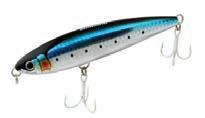



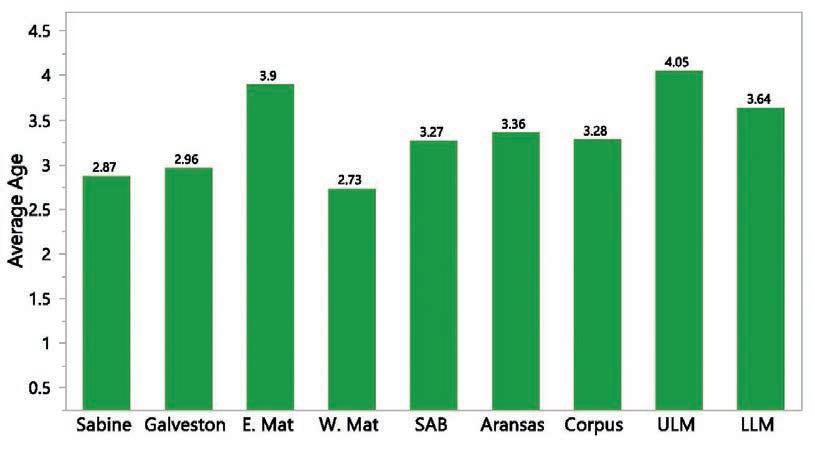
Combined with previous genetic research in our lab, these findings underscore the fact that there is a lot of spatial variability in the biology of Spotted Seatrout in Texas; so much so that we might consider the northern, central, and southern coasts to be functioning as somewhat independent populations. This regionalization of Spotted Seatrout populations has been realized through regionalization of fishery management regulations through time (for instance, historically regionalized bag limits
in the Laguna Madre). Our 20 years of otolith collections have helped us understand how key biological parameters might be changing through time and across the Texas seascape for Spotted Seatrout, and will ultimately be used to help us design future fishery management regulations that are anchored tightly to the biology of this extremely important Texas sportfish species.
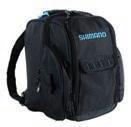
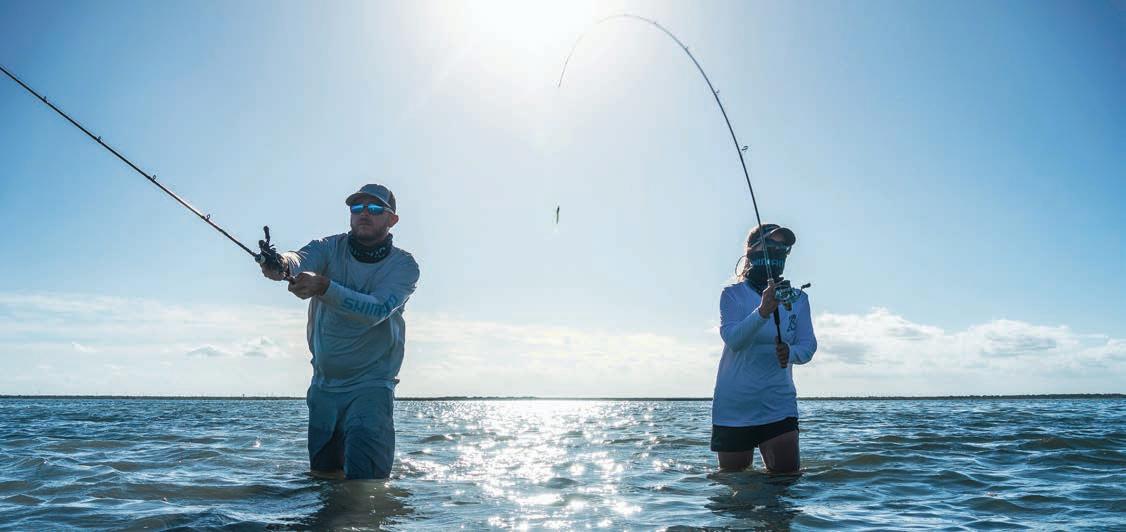
Check the TPWD Outdoor Annual, your local TPWD Law Enforcement office, or tpwd.texas.gov for more info.
2 roysbaitandtackle.com
DOMINATE THE INSHORE REALM 42 | July 2023
Figure
BLACKMOON BACKPACKS

GREAT START TO SUMMER
It’s no secret, the string of hurricanes, floods, and freezes that occurred along our Upper Coast region over the past decade had significant negative impact on our fisheries. Luckily, the past couple years have delivered a rebuilding trend, and although it has been a slow process, we are finally seeing signs of progress. Summertime is here and that means there are a lot more anglers on the water enjoying our resources. What is different from years past is that I have been noticing a huge increase in fishing reports and pictures of fish being caught. Hopefully this year will be the turning point and we will continue to see plenty of reports of healthy fish in our lakes and bays.

Among the positive signs, we enjoyed a day recently that began with light north wind, just enough to keep the temperatures cool and the water calm. Normally, during late-spring, we get short windows of only a day or two with light wind. This one was very different, it stuck around for a little over two weeks. A very unusual pattern, and boy, did the fishing turn on! Greenish-blue water from the Gulf came rolling in, all the way to the beach. I cannot recall ever seeing the water at the Sabine jetties so clear. You could see the rocks plainly, nearly all
the way to the bottom.
Along with that wonderfully clean water came the pogies. Now, seeing schools of pogies is nothing rare on the beachfront, or even in Sabine Lake for that matter. However, what was astonishing was their numbers. I saw schools just outside the pass that you would have to measure in tens, if not hundreds of acres. It was truly an incredible sight and hopefully an accurate indication of how healthy our estuary and the Gulf have become.
Once getting on the water and seeing the amount of bait that was present, I knew the gamefish could not be far away…and they were not! You could see them jumping, thrashing and crashing the huge school of pogies. The jack crevalle and bull reds roamed thick along the beachfront and this made for fun mornings. I know most people don’t mess with the jacks, but I just can’t resist. They’re explosive, aggressive, and arguably one of the hardest-fighting fish that you will ever hook into. I had a few buddies that have never had the opportunity to catch one and told them to get on the boat – It’s time. It didn’t take long to find them and they quickly hooked up. Needless to say, they fell in love and quickly learned what all the fuss was about.
 DAVE ROBERTS SHALLOW WATER FISHING
DAVE ROBERTS SHALLOW WATER FISHING
44 | July 2023
In addition to the endless amounts of jacks, the bull reds were also doing their thing within the first few sandbars of the beach. It never ceases to amaze me watching them destroy everything in their path. A wellplaced topwater or larger swimbait is all you need to trick one into eating!
While running around looking for schools of jacks and bulls I began noticing numerous tripletail floating at the surface. Knowing they can be picky, I decided that a well-placed shrimp pattern fly would likely be the best approach. The smaller ones could not resist but the bigger ones weren’t quite so easy to fool. It is still fun and challenging because an accurate cast is a must with these fish.
The surf was a great place to be for a few weeks at the beginning of summer but Sabine Lake was equally as good. Whether fishing from a boat, kayak, or from the shore, you had a great opportunity to land a few fish. We have been seeing great reports from several people fishing off Levy Road on Sabine. Multiple people were catching limits of trout and the location along the miles of road didn’t seem to have an effect on the outcome; being there at daylight was the key. Out on the lake there was no shortage either. A good outgoing tide would begin to pull some shrimp out of the marsh and all you had to do was look for birds hovering above them to find fish.
I spent one day on the Louisiana shoreline after my trolling motor batteries died. I had planned on staying in the marsh looking for redfish but that quickly came to an end. I figured I might as well fish the best way I could and decided to try a new spot, hoping to find a few trout. That spot didn’t disappoint as I got into a steady trout bite that lasted at least an hour. The beautiful thing was that every trout I caught was between 16”-20” and never a smaller fish in the mix. It has been years since I have been able to put together a limit of five trout without weeding through dozens of 12-inchers. I can’t express how wonderful it is to finally see good numbers of great fish being caught on Sabine.


So far, fishing has been lights out and it feels good to be able to say
that. Hopefully the weather will cooperate as summer rolls along and the trend will continue. Summer has arrived and right now is a perfect time to get you and the family out to enjoy our resources.
Chasing Schools of Jacks
CONTACT
Email: TexasKayakChronicles@yahoo.com
Website: www.TexasKayakChronicles.com
 Dave Roberts is an avid kayak-fishing enthusiast fishing primarily the inshore Upper Coast region with occasional adventures to surf and nearshore Gulf of Mexico.
View The Video Open Camera and hover over QR Code. When link appears at top of screen tap to open in YouTube.
Dave Roberts is an avid kayak-fishing enthusiast fishing primarily the inshore Upper Coast region with occasional adventures to surf and nearshore Gulf of Mexico.
View The Video Open Camera and hover over QR Code. When link appears at top of screen tap to open in YouTube.
TSFMAG.com | 45
OYSTER LEGISLATION PASSED –OUR VISION BECOMES REALITY
Signed by Governor Abbott on May 27, 2023, Senate Bill 1032 will go into effect on September 1, 2023, providing Texas Parks and Wildlife Department (TPWD) and stakeholders with the opportunity to develop a new(ish) program – The expansion and creation of on-bottom oyster leases. This bill is a common-sense approach that will provide stability, certainty, and increased business opportunities for the oyster industry, as well as substantial restoration opportunities for conservation organizations. As you may recall, we spelled the need for this out in our November 2021 Letter to the Texas Parks and Wildlife Commission.
Per the bill analysis, S.B. 1032 redefines a “natural oyster bed” to include the area for leases, especially in areas considered degraded. Previously, the only “areas under location” (leases) were 2,300 acres of mud bottom in Galveston Bay that were utilized for transplanting oysters from closed areas to open areas, allowing the oysters to depurate and become safe for human consumption prior to harvest. Over time, practices within these areas evolved as leaseholders began to “plant” these areas with new substrate, often limestone and river rock, to recruit wild spat and create next year’s harvest opportunity. This new language will allow TPWD to identify areas of the bay where oyster reefs used to exist and hard bottom remains while utilizing industry members and conservation organizations to revitalize these locations into thriving reefs. The commercial leaseholders would have exclusive harvest rights within their lease and the restoration leases would be off limits to commercial harvest.
Oyster leases are clearly distinct from the pillage that occurs on public reefs every year, as the leaseholders are careful not to overwork their lease and they continually cultivate their beds with shell planting and strategic management practices. While oyster leases can’t compete
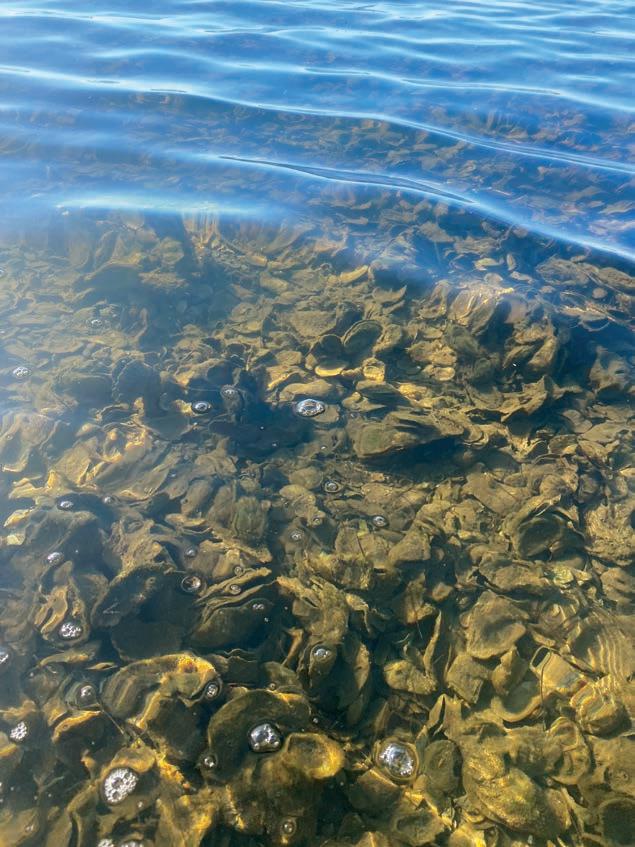
with oyster mariculture when it comes to half-shell presentation and consumer preferences, they are the next best thing.
The significance of S.B. 1032 can’t be overstated, and we owe a significant debt of gratitude to Senator Lois Kolkhorst and Representative Todd Hunter for carrying this bill during this past 88th Legislative Regular Session. We have stated time and time again that “we all want more oysters,” and this bill will see to it that our vision becomes a reality.
Key takeaways for Senate Bill 1032.
1) Ensures that there will be more areas of oyster reefs to harvest along the Texas coast.
2) Allows for the expansion of the private lease (certificate of location) program in the oyster fishery.
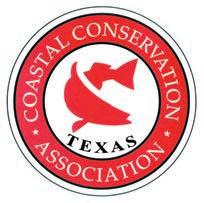
TSFMAG CONSERVATION NEWS
Shane Bonnot, CCA Texas Advocacy Director
46 | July 2023

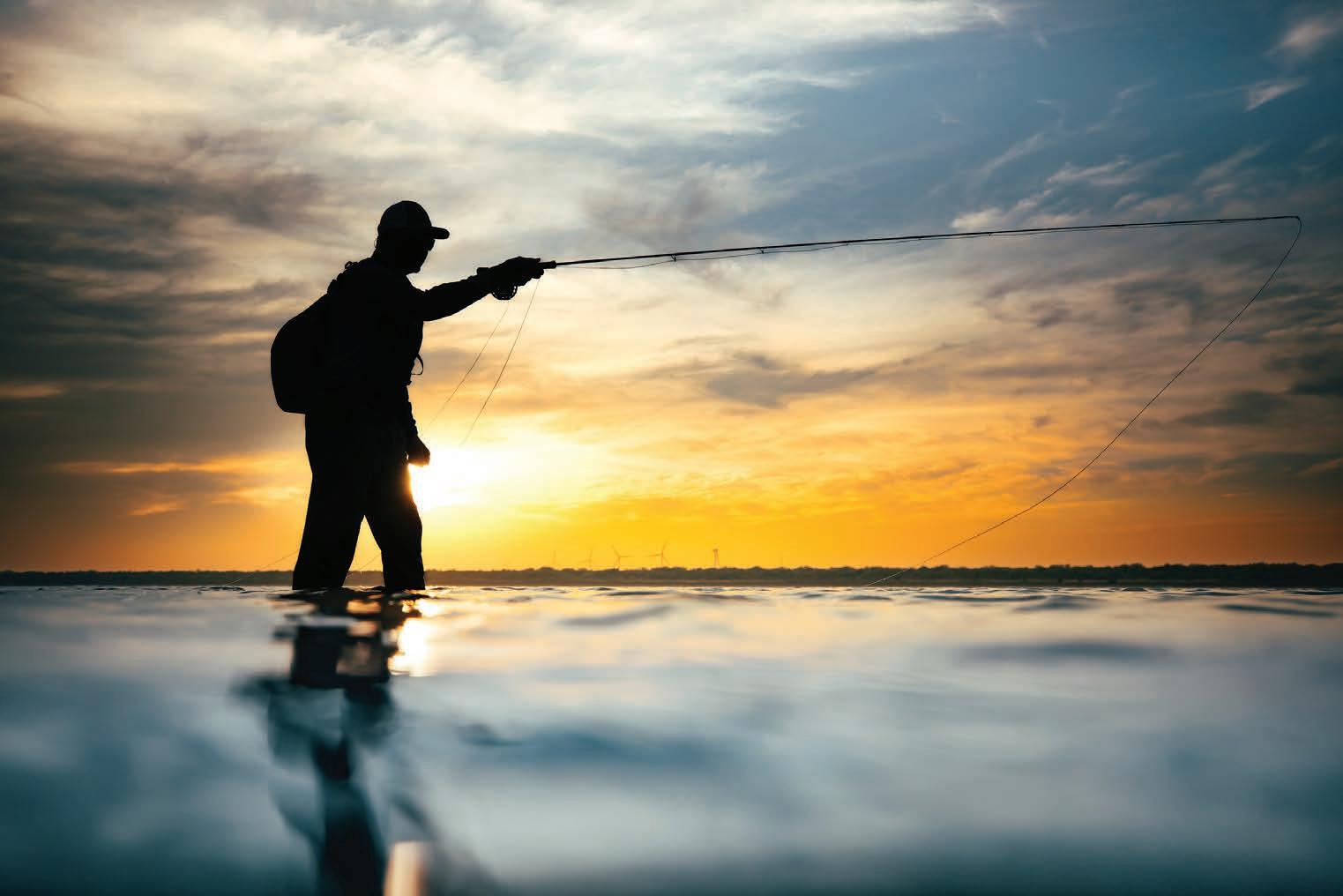










TSFMAG.com | 47 May 27-Sept 4 Two Ta ed Redfish Divisions, Inshore Division, O shore Division, Guides Division and Youth Scholarship Divisions Winner Spotted startournament.org ccatexas.org By entering the CCA TEXAS STAR you have a chance to win a 2023 FORD F-150 XLT SuperCab, Boats, Prizes, Scholarships and more! PHOTOS ARE FOR REPRESENTATIONAL PURPOSES ONLY HOUSTON $ 1, 0, 0 In Prizes and Scholarships YOUR CHANCE TO WIN UP TO 18 BOATS · 5 TRUCKS · 5 UTVS and $325, 0 IN SCHOLARSHIPS A MEMBERS AGES 6-17 FISH STAR FR ! May 27-Sept 4 Two Ta ed Redfish Divisions, Inshore Division, O shore Division, Guides Division and Youth Scholarship Divisions PHOTO COURTESY OF MAC ELLIOTT
Calls for TPWD to work with the Department of State Health Services and Texas General Land Office in considering these expansions.
4) Calls for TPWD to create program restoration guidelines for groups that want to help support oyster restoration.
5) Redefines a “natural oyster bed” to activate more areas where leases could be sited and aid in oyster resource recovery through additional consideration of leases in degraded areas.
6) Removes the need to transplant which will more effectively illustrate the reality of how oyster leases are being utilized.
In other news, the Gulf of Mexico Fisheries Management Council is set to meet August 14-17, 2023, in Austin at The Driskill. Please mark your calendars because we may be looking for participants to provide public comment on potential state surveys on private angler landings of Red Snapper and general observations on Amberjack.
Finally, regarding speckled trout, the temporary 3-fish bag limit with a 17-inch to 23-inch slot restriction will expire on September 1, 2023, and revert to the historic 5-fish bag limit with a 15-inch to 25-inch slot, and the allowance for 1 fish over 25-inches. While there is still some debate over whether the fishery has recovered, the expiration date was set in statute, therefore outside of an emergency ruling, any additional changes will be subject to the rule-making process.

O ther CCA h A ppenings
By John Blaha
As we close out the first half of 2023, CCA Texas staff and volunteers
have enjoyed a very successful first half of 2023. Through the end of June, thirty-six local chapters have hosted their annual fundraising/ membership banquets. More than half of these events were sold out, and many have set record attendance and fundraising marks that continue the rich history of conservation of Texas’s coastal resources. The North Texas Chapter became the 60th local chapter and held their annual banquet on June 1, 2023. The strength of the organization continues to be the grassroots efforts across the state. Many thanks to our local chapter volunteers, sponsors, donors, and banquet attendees that come out to support the efforts of CCA Texas.
Habitat work continues to move forward along the coast. CCA Texas funding was recently approved for a $200,000 funding request from Friends of RGV Reefs (FRGVR) to place materials in multiple sites including the new Causeway reef site out of South Padre Island and MU775 located between Packery Channel and Port Aransas. Another $50,000 was approved for Phase II design for Texas Parks and Wildlife Department’s (TPWD) Newcomb Marsh Shoreline Protection project in Copano Bay. These funds are part of the necessary community match for the CEPRA grant TPWD has applied for. This grant will provide for the final engineering phase of the project and bring it to Phase III, the construction phase. As part of the Texas Coastal Resiliency Plan and a Tier 1 project, CCA Texas looks forward to seeing this project move through this phase and into final construction phase.
For more information about CCA Texas, be sure to visit www. ccatexas.org and visit us on social media at https://www.facebook. com/CCATexas/, Instagram @cca_texas, and Twitter @CCA_Texas.
3)
48 | July 2023







(860) 749-3476 Sales@REC.com www.REC.com MATTERS GUIDE CHOICE LAUNCHING RECOIL XL® SERIES AT BOOTH #625 REC’s new RECOIL XL® guide series is the innovation the fishing rod industry has been asking for. RECOIL XL® guides make the best fishing rods on the planet even better. Additional information will be available soon regarding what makes RECOIL XL® unique. • 100% Nickel Titanium Shape Memory Alloy • Corrosion Proof • Uniquely Flexible –Eliminates Blank Flat Spots • Virtually Indestructible • Extreme Light Weight • Extremely Wear Resistant MADE IN USA ALLNEW RecoilXL® Original Recoil® 50% TALLER AVERAGE GUIDE HEIGHT TSFMAG.com | 49
GHOST SHRIMP
Ghost shrimp are small, soft, and translucent crustaceans of the intertidal zone. Despite what their name and appearance suggest though, they are more closely related to crabs. Their carapace is usually very pliable, and their bodies are long and narrow, almost more lobster-like than shrimp-like. They typically reach up to 3 or 4 inches in length. Some of the species found on the Texas coast include the estuarine ghost shrimp (Lepidophthalmus louisianensis), the broadspine ghost shrimp (Dawsonius latispinus), and a somewhat more recently described species, Lepidophthalmus statoni. They range from a mostly-transparent pink to orangish, with white legs and tail fans, and one enlarged, wide claw.
To move around, ghost shrimp rely on drag-powered swimming. Drag swimmers move their limbs in a cyclic motion. When they push water backwards, this moves their body forward. But as their limbs return to the starting position, they push water forward, moving them backwards in the opposite direction their body is heading. This opposing force is called drag. It’s like a 3-steps-forward, 1-step-back mode of travel. Their notentirely-efficient movement strategy is fueled by a diet of diatoms and dinoflagellates.


Estuarine ghost females reach maturity within their first year, at a length of less than half an inch – males, a little larger. Eggs become apparent beginning in December. The first juveniles large enough to be caught in samples appear by early spring. Some anglers use ghost shrimp as bait, sucking them out of their burrows with a plunger-like sand pump (limit of 20 per day). As they are also a food supply for migratory birds, some
areas are protected from ghost shrimp harvest.
Commonly inhabiting the mud, sand, and clay of euryhaline inlets, estuaries, and protected shorelines, and generally found at the water’s edge, ghost shrimp burrow down in seafloor sediments to collect bits of food. They can survive for up to six days without oxygen. The little volcano-like holes in the sand you can see at low tide are ghost shrimp burrows. These burrows, found in intertidal and shallow subtidal waters, can be up to 4 feet deep and are an important part of the intertidal ecosystem. They influence sediment structure and disperse oxygen and nutrients throughout the sediment. The oxygen helps organic matter decompose, enriching the sediment, which benefits the neighbors too.
An ecosystem is an interconnected system of organisms living in a landscape (or seascape). Removing an element can cause the system to change in unexpected ways, much like pulling out a Jenga stick. Some ecosystems are created by “ecosystem engineers.” Beavers, for example. Their dams alter the environment by flooding lowlands around rivers, and providing new habitat for fish, insects, plants, and birds. Burrowing shrimp, such as our ghosties, are also ecosystem engineers. But because they live out of sight underground, many people aren’t familiar with their architecture. At the water’s edge, the world underneath your toes is a complex and dynamic network of burrows and galleries – like the inside of an ant mound. These burrows are constantly changing and influencing their surrounding environment, mixing up and exchanging organic materials between the water and the sediment.
STEPHANIE BOYD FISHY FACTS
50 | July 2023
Estuarine ghost shrimp. Photo courtesy of Texas Marine Species.


TSFMAG.com | 51
Because they play a large role in balancing nutrient levels, if they suddenly disappeared, we don’t really know what the consequences would be, but a huge algal bloom seems likely.

Oysters are also ecosystem engineers, but because we like to eat them, they have a multimillion-dollar industry looking out for their interests. Unfortunately, ghost shrimp and oysters have some overlap in the habitat they prefer, so ghost shrimp often end up being labeled as pests. In some states, burrowing shrimp are even targeted with topical pesticides to clear more areas for oysters. However, some research has been carried out that will help identify likely areas of high and low shrimp growth, so that aquaculturists can choose locations that are productive for oysters but not disruptive to ghosties, allowing both to thrive in their respective environments.
Where I learned about ghost shrimp, and you can too!
Padre Island National Seashore www.nps.gov/pais/learn/nature/ghostshrimp.htm
TPWD tpwd.texas.gov/regulations/outdoor-annual/fishing/shellfish-regulations/craband-ghost-shrimp-legal-devices-and-restrictions

Texas Marine Species
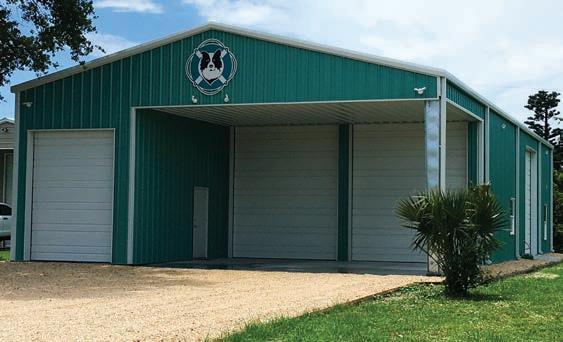

txmarspecies.tamug.edu/invertdetails.cfm?scinameID=Lepidophthalmus%20 louisianensis
txmarspecies.tamug.edu/invertdetails.cfm?scinameID=Dawsonius%20latispina txmarspecies.tamug.edu/invertfamilydetails.cfm?famnameID=Ctenochelidae
World Register of Marine Species www.marinespecies.org/aphia.php?p=taxdetails&id=101839# www.marinespecies.org/aphia.php?p=taxdetails&id=421828# www.marinespecies.org/aphia.php?p=taxdetails&id=954520#
National Library of Medicine pubmed.ncbi.nlm.nih.gov/26250042/
Encyclopedia of Life eol.org/pages/46517481 eol.org/terms/glossary/d/https:%2F%2Feol.org%2Fschema%2Fterms%2Fdrag_ based_swimming
NOAA
www.fisheries.noaa.gov/feature-story/estuarine-engineers
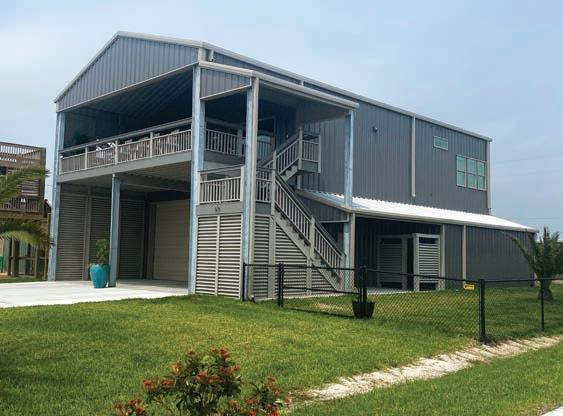
Springer Link link.springer.com/article/10.1007/s12237-016-0193-y
Oxford Academic academic.oup.com/jcb/article-abstract/9/4/540/2327504?login=false
View The Video

Open Camera and hover over QR Code. When link appears at top of screen tap to open in YouTube.
Catching ghost shrimp

Call us for custom buildings and homes on your own property! 361-576-3825 Office | 361-576-3828 Fax 36 Hunters Circle, Victoria, TX 77905 www.RafterJConstruction.com Barndominiums • Metal Buildings • Boat and Mini Storage • Metal Frame Homes • Commercial Buildings
“We contracted the construction of the TSFMag office building with Farrell Jackson. Jackson also built my son’s bay house here in Seadrift. We were completely satisfied with both projects…a professional and trustworthy contractor.”
52 | July 2023
~ Everett Johnson | Editor/Publisher, TSF Mag
The Migration of Whale Songs

It’s not just whales that migrate thousands of miles across the seas. The songs they sing can cover long distances too. Several recent studies reveal more insight into the hauntingly beautiful and complex musical arrangements of male humpback whales, including just how far the repeating “themes” of their songs can travel.
Researchers have long known that humpbacks weave together repeating phrases, called themes, in their songs. Typically, a population shares these themes, though individuals may arrange them in different ways. Scientists then learned just over two decades ago that humpbacks on Australia’s west coast were sharing themes with others on the east coast. Further research revealed that songs from the east coast whales made it as far as French Polynesia, more than 3,700 miles away.
Then last year, marine biologists discovered those songs migrated nearly 5,000 miles further east over a three-year period, making it across the Pacific Ocean to the coast of South America. Early evidence suggests the songs could possibly travel even further, from the Ecuadorean coast to Brazil’s waters and then across the Atlantic to the South African coast, but a complete circumnavigation of the globe has not yet been confirmed.


The themes can undergo small changes as they pass from one population to the next, similar to the whispers from one ear to the next in a human game of “Telephone.” Researchers don’t entirely understand why one population might borrow another’s track or how the songs are shared. But they have learned in another study that humpbacks sing louder when the wind is loud—though not when noisy boats are around, even if the overall volume of the wind and boat noise are similar. Together, these findings reveal just how much more there is to learn about humpback’s mysterious songs.




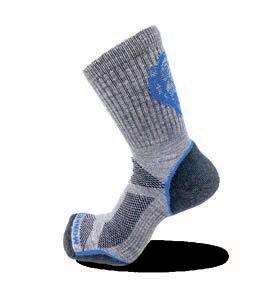
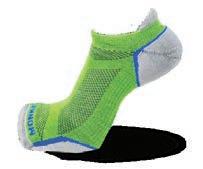
fishmonkeygloves.com 100% Satisfaction Guaranteed Made in the USA INTRODUCING PERFORMANCE WOOL FISHING SOCKS to FISH www.ScienceAndTheSea.org © The University of Texas Marine Science Institute Science Sea
TM
and the
TSFMAG.com | 53
Similar themes in humpback whale songs have been heard thousands of miles from the population of origin. Photo credit: Sylke Rohrlach, CC-BY-SA-2.0.
ERIC OZOLINS EXTREME KAYAK FISHING & SHARKS FROM THE SAND


MAGICAL MAYHEM
While fishing for sharks in the surf for more than twenty years, I’ve spent every season of every year observing how the weather affects the fishery. The most obvious aspect of Texas weather, especially along the coast, is the way it almost constantly changes. Different seasons generate different types of changes, of course.
In winter, cold fronts normally pass over the coastal waters every few days or so, bringing strong north winds and rough conditions. Often, in the wakes of these fronts, relatively calm windows of excellent potential develop in the surf, usually lasting just two or three days.
Summer is the time of least change, usually offering reliably calm seas and clear water. Afternoon winds normally kick up just above the gentle gradient and taper off overnight. This kind of consistent, benign weather makes for the easiest fishing in the surf, overall.
The two transitional seasons present the biggest crapshoots regarding weather patterns. Early cold fronts can cause some issues for anglers at the beginning of autumn, but when summer lingers into early-fall, phenomenal conditions usher in high levels of activity among the creatures that frequent our surf.
On average, spring offers the most chaotic weather patterns, with the highest potential to wreck the efforts of anglers headed to the beachfront. This year, we certainly had an unexpected but welcome run of weather during the month of May, a change from the long-term norm. I most often mention change in a negative context, but the results from this change were nothing short of magical.
No one could have predicted the events that unfolded
just prior to June this year. Historically, April and May rank as the two windiest months in South Texas, with onshore breezes often blowing twenty to thirty knots for days on end. This year, winds fell almost silent and the Gulf waters calmed to nearly flat from the middle of May all the way into the first days of June.
By far, this is the longest run of calm weather I’ve seen during this timeframe. Normally, we might expect to have light winds for four or five days in a row, but a calm window lasting upwards of two weeks during one of the predictably windiest months is virtually unheard of. These conditions would have astounded many of the old-timers, who thought of sharking season as beginning around Memorial Day and lasting until Labor Day. Many big shark fishermen still frame the season in this way, mostly because of the generally calm, consistent weather patterns that prevail during the hottest season.
The ultra-calm conditions in May created crystal clear water in the surf zone. Because of the rare opportunity the situation presented, a multitude of anglers made their way to the beaches. The number of anglers reached levels we typically don’t see until later in June. The whispering winds and clear water did more than attract shark fishermen to the coast; it also invited a variety of shark species to the shallows!
Monster sharks came cruising through in the largest numbers I’ve ever seen at this time of year. Mega hammers hitting the fourteen-foot mark, beefy tigers, massive bulls and even some stray dusky sharks made their presence known. Prior to this year, over the decades, just two hammers measuring fourteen feet were landed
54 | July 2023
Young angler, Elijaah Beougher, poses with a fine PINS blacktip.
ONE TRIP TO SOUTH PADRE ISLAND, AND YOU’RE SURE TO BE HOOKED.












Experience the difference with Okuma Rockaway Surf Reels. Crafted with a longcast spool design and a lightweight corrosion-resistant body, Rockaway reels feature stainless steel bearings and over 40” of line pickup. With a max drag output of 35 lbs, rigid metal handle design, and Cyclonic Flow Rotor (CFR) to minimize corrosion, these reels are designed to perform at their best in any surf situation. okumafishingusa.com
RBF-8000
INSPIRED BY THE SURF
TSFMAG.com | 55
RF-6000
from the Texas surf—Ray Cedillo’s beast and my 14’8” monster. Amazingly, during just this one historic month of May, Texas sharkers landed FOUR more great hammerheads measuring at least fourteen feet!
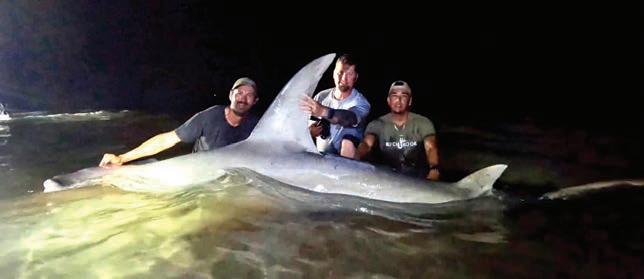
Granted, more anglers than ever are fishing for big sharks in Texas, and they’re doing so with better knowledge and equipment, but the production of so many giant sharks during one prime window of opportunity proves nothing short of spectacular. During the first week of the uncannily awesome weather, I decided to avoid the crowds and fish farther south than normal. This led me to the least-traveled sharking destination on the Texas coast, the beaches of South Padre Island.
While the beaches of Padre Island National Seashore north of the Mansfield Jetties are my main stomping grounds, I do appreciate a change of scenery once in a while. On one of May’s memorable trips to South Padre, I fished with Tim Hill and Carol Cox, two experienced shark anglers who wanted me to show them a few new tricks. My buddy Joel Ybarra, a young and successful guide in the area, had given me some helpful intel. A hard-working guide who shows a high level of respect and appreciation for the fishery, Joel was responsible for putting two of this year’s fourteen-foot hammers on the beach.
On the trip with Tim and Carol, I wasted no time before deploying big baits. As a rule of thumb, the clearer the water, the later the sharks will bite. When the water becomes crystal clear, the bites will likely happen very late in the afternoon, or at night. Kayaking the baits out beyond the guts, I noticed pods of cruising tarpon. Tarpon rank high on the list of the hammerheads’ favorite foods, so I expected we’d encounter some of the hunting brutes before long.
Our baits soaked without getting any attention for the first few hours, but just before sunset we hooked our first fish, and Tim began a battle with a smoker of a shark. Almost instantly, I knew it was a hammer. After a solid thirtyminute battle, Tim brought the hammer to the beach – it stretched the tape to an impressive 11’8”. We all experienced a satisfying thrill when we watched the beast swim off vigorously after release. The next morning Carol brought a solid tiger to the beach, so South Padre did not disappoint. A couple days later, my personal thirst urged me on a solo journey to PINS. Right before dark I deployed three large baits. That night, two baits were picked up; I landed a ten-foot hammer and an eight-foot bull. I then gained full appreciation for the magnitude of the event, with such an insane amount of early-season giants roaming our beachfront waters.
Over the next few days, many large sharks were landed by other anglers. Tigers measuring up to twelve feet were hitting the sand, along with even more big hammers. With so much banter about these events appearing on social media platforms, many people headed to the ocean’s edge. I’d say most all the people who had the good fortune to take part in this prolifically productive period during May were handsomely rewarded.
As of this writing the Gulf is chock-full of sargassum weed, creating uncertainty as to what summer may have in store for us. Will we be weeded out? Will we get slammed by tropical weather events?
Or, will we be rewarded with the most epic season of shark fishing imaginable? We don’t know the answer to these questions, but we do know we’ve already experienced something historically magical.


CONTACT
For the past decade Eric ‘Oz’ Ozolins has been promoting shark catch and release and assisting various shark research programs. Eric offers guided shark fishing on Padre Island National Seashore. Also renowned for extreme kayak big game fishing, Eric is the owner of Catch Sharks Tackle Company.
Email oz@oceanepics.com Websites oceanepics.com | catchsharks.com
Mega-hammer for Joel Ybarra and charter clients.
Big bull during successful release, landed by author, Eric Ozolins.
56 | July 2023
Tim Hill assists a hammerhead during successful release on South Padre Island.
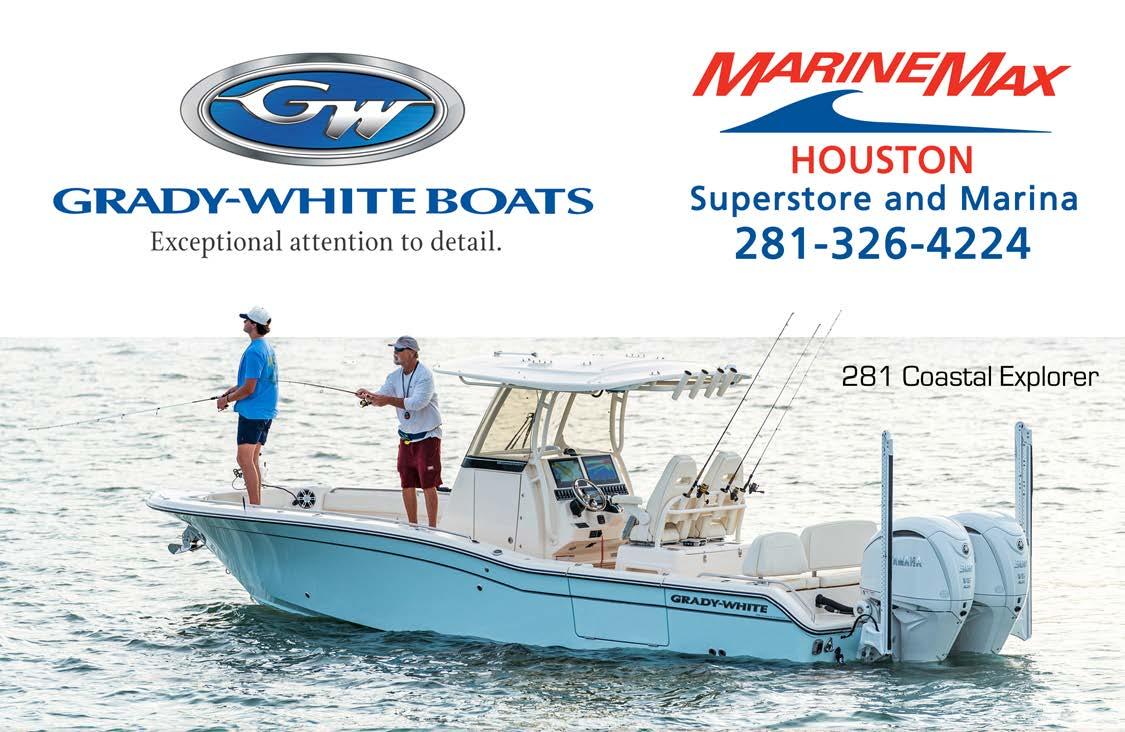

TSFMAG.com | 57
JAKE HADDOCK
MOSTLY SIGHT-FISHING
SPIN TO WIN
It’s no conspiracy theory that Texas’ coastal waters have received a significant increase in angling pressure in recent years. Thanks to “work from home” jobs, even a weekday outing can feel a bit crowded on the water. This gives our flats fish fewer rest days and can make catching them increasingly difficult.
Being a guide, I must be prepared to take anglers of all skill levels in a variety of conditions. This is where a spinning rod truly shines. A spinning rod properly set up can allow an angler to cast a light lure greater distance,


placing a small offering within the strike zone of a fish that may not be willing to hold within a hundred feet of a skiff. Stubbornly sticking with a fly rod could land you a goose egg on a day when the fish can be a bit negative. Some anglers are just fine with that, and I totally get it. Believe me, I’ve caught my fair share, yet I still like to catch a few even of the toughest of days.
To me, a spinning rod is just another useful addition to the angler’s tool kit. Much like you wouldn’t work on your broken-down truck with only flat-head screwdrivers, I don’t leave the dock with only one type of rod and reel. Unless, of course, this is requested by a client that is “fly or die” and sees a spinning rod as some form of taboo.
To achieve presenting a finesse bait to wary redfish on a gin-clear flat, you’re going to need the right stick. Although I’m still hunting down the absolute perfect spinning rod for this purpose, I have gathered a good basis of data to work from. A power rating of mediumlight is a good starting point; however, this can vary slightly based on the manufacturer. For length, 7 feet to 7 feet 2 inches is good for the job at hand although some may argue that a 7 feet 6 inch rod with a slower action is just right for casting a light bait. Keep in mind, however, we still want to be accurate at shorter distances for sight-fishing opportunities.
Line ratings can be a bit squirrely in this class of rod. Currently I have medium-light spin rods with ratings from 6 to 8 pounds, 4 to 10 pounds, and 6 to 12 pounds. All of these rods are suitable for the 8 pound test braided line I plan to use. The rod manufacturers lure rating is probably the most important specification to pay attention to for selecting this type of rod and I have found them to be fairly accurate.
 Mr. Bennett with a bonus redfish on spinning tackle after the fly bite slowed.
Mr. Bennett with a bonus redfish on spinning tackle after the fly bite slowed.
58 | July 2023
Hand-tied bucktail jigs are great for extra-spooky reds.
For the sight-fishing scenario, I’m looking for a rod that is designed for 1/8 ounce lures on the low side, and anywhere from 1/4- to 1/2-ounce on the high side.
In addition to the length and action playing large roles in my rod selections, there are two other small, yet important details I look for in a light-tackle spinning rod. First, is the placement of the hook keeper so that it’s not likely to hang the line during a cast. This could be on the top side of the blank just above the reel seat, or if it’s a split grip, in between the butt and reel seat. The most foolproof is actually no hook keeper at all. The majority of the time, clients will place the hook on one of the eye guides frames anyway. The second small detail I look for is the style of the tip guide. My preference here is one that is at least as large (or even larger) than the last running guide, with curving support braces to enable line to flow freely and combat the “tip wrap” that is so common when using light, braided fishing line.
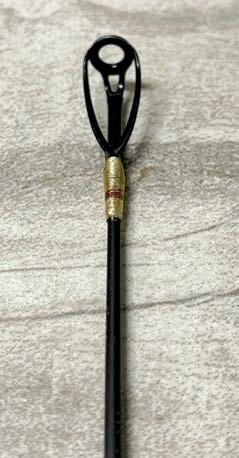
My go-to reel to complete this combo is the Shimano NASCI in the 3000 size. I’m not on any kind of Pro-Staff with Shimano; this is just a truly great reel for the money. Now that you have a reel, you need some line. I recommend filling about 1/4 of the spool with 8 pound test monofilament for backing. Mono will lock onto the spool better than tying braid directly and will save you money each time you respool. For the main line, I prefer four-strand braid. Lately, I have been liking Cortland Master Braid. As mentioned above, I tend to favor 8 pound test. If you’ve never thrown anything this light, you may want to start with 10 or 12 pound test and then work your way down after building confidence. Following the main line, you’re going to want a leader. Not only will a leader give you some shock absorption when trying to land a fish boatside, it will also give you something to grab, keeping the thin braid from cutting your fingers like a knife. With 8 pound test braid, I prefer to make a stepped leader and start with about 2 to 3 feet of 12 pound fluorocarbon tied with a uni-to-uni connection knot. From there you can connect about an 18 inch section of 20 pound fluorocarbon with a blood knot. This is the most reliable leader I have found that’s easily repaired on the water. Believe me, I have tried all the fancy, new-fangled braid to leader knots.
So now that you’ve got the right rod, reel, line, and leader, you
might say, “Well, what lure should I tie on?” I like to start with a small paddletail for most flats fishing scenarios. Over the last couple of years, I’ve favored the Down South Burner Shad with a 1/16 ounce KWigglers 2/0 jig head. If you need to downsize from there, I like the Gambler 3 inch TZ, which would pair well with KWigglers’ new 1/0 jig heads. When the wind picks up and there’s lots of grass starting to snag your hook, switch to a Johnson 1/8 ounce weedless gold spoon. If the wind gets downright snotty, bump up to a 1/4 ounce spoon, which with this rod and reel combination you can throw a country mile. On the flip side, when it’s dead calm, sunny, and the fish are scared of their own shadow, fall back to a lure as old as time that not many people use anymore – the bucktail jig. A 3/16 ounce bonefish style head on a 2/0 hook tied in all white can be a deadly bucktail for sightfishing. Throw this a bit beyond a targeted redfish and reel it up to their nose; let it drop; then when the fish moves towards the jig, lift your rod and watch the fish inhale it!

A light spinning outfit, like the one we have covered here, is a great tool to add to your arsenal. You can put a very fishable combination together for around $300. In addition to being a great rod for spooky redfish, it can also help an angler of any skill level throw small lures greater distances, thereby increasing their catch ratio a bit. So, next time you’re at your local tackle shop, pick up a new medium-light spinning rod and 3000 size reel. Don’t be surprised if it becomes your favorite combo in the boat!
Jake Haddock grew up in the back bays of Port O’ Connor where he developed a great passion for saltwater fishing. In his younger years he was a youth writer for this publication. In present day he enjoys guiding light tackle and fly clients in Galveston and occasionally Port O’ Connor.
Phone 713-261-4084
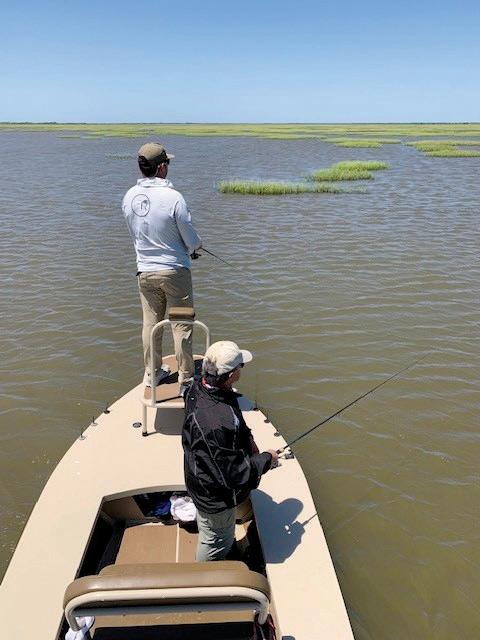
CONTACT
Website www.frigatebirdfishing.com
Email frigatebirdfishing@gmail.com
Switching to spinning gear can be a great option on 30+ wind days.
Tip guides with curving braces help prevent annoying “tip wrap” with light, braided line.
TSFMAG.com | 59
My go-to lures for light spinning gear on the flats.
Seaguar’s New Tactx™ Camo Braided Line
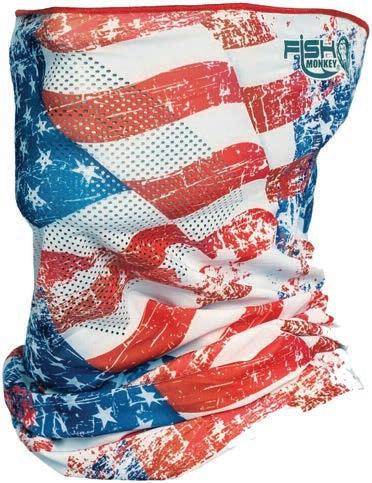
Seaguar TactX™ Braid and Fluoro Leader Kit is a perfect choice for everyday anglers. This 4-strand braid is engineered to maintain a perfectly round shape to minimize rod tip wrapping and wind knots. It packs tightly without cutting into itself, which helps reduce dreaded backlashes.
Woven from multi-color earth-tone strands and then heat-set for color retention, creates a natural camouflage color that reduces visibility. Its round nature gives it excellent castability, abrasion resistance, and overall strength with a “pebble” texture to add durability and cut through vegetation.
Inside each box of TactX™ is a 5-yard Seaguar fluorocarbon leader material to allow anglers to experience a braid to fluorocarbon connection with a quality leader material. Available in 10, 15, 20, 30, 40, 50, 65, and 80lb tests in both 150 and 300-yard spools Seaguar.com/products/tactx?variant=42982588580059
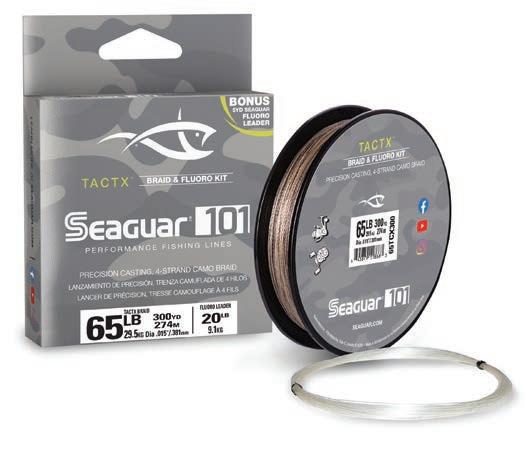
ZMan Kicker CrabZ™
A first of its kind crab imitation, the Z-Man Kicker CrabZ accurately imitates a sideways swimming crab—the exact action that’s hotly pursued by redfish and other inshore predators. Buoyant 10X Tough ElaZtech material mimics the natural defensive upward claw posture of crustaceans, while outlasting other soft plastic baits by wide margins. Realistic crab profile sports lifelike kicker claw, segmented legs, eyes and antennae. Angler-friendly design yields easy rigging (with hookslot/ hook pocket) and streamlined shape for max casting distance. The Kicker CrabZ’ keeled belly enhances retrieve stability. Expertly designed kicker claw produces movement and vibration at all retrieve speeds, including on the fall. Pairs perfectly with the Z-Man Pro BulletZ, SnakelockZ and ChinlockZ jigheads. Ten striking inshore colors available. MSRP $4.99 per 3-pack. www.ZManFishing.com
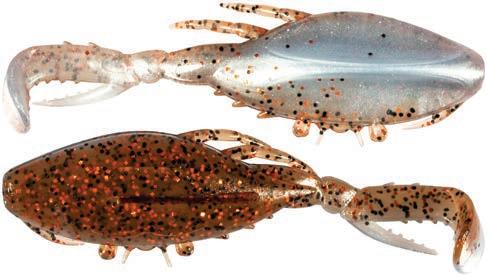

NEW! Fish Monkey Faceguard
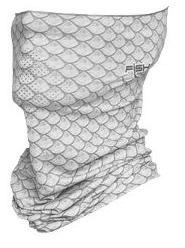
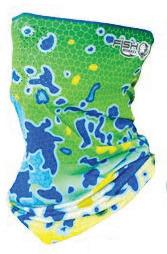

Today’s anglers are more aware than ever of the harmful damage the sun can cause. For years, fishermen have turned to faceguards, but most are just a simple tube of fabric left over from performance shirts. They don’t breathe well and promote fogging when wearing sunglasses.
Fish Monkey turned the corner to eliminate these issues. The flared design greatly improves comfort. Our faceguard is worlds apart from the traditional tube.
We also fixed the fogging problem. A series of laser-cut holes in the mouth area virtually eliminates fogging, while offering less restriction and heat retention.
Fish Monkey faceguards provide UPF 50 sun protection for as long as you own the product. And because it’s a lightweight synthetic material, it’s also highly moisture-wicking and won’t retain odors from perspiration.
FishMonkeyGloves.com
NEW
60 | July 2023
SPRO Chrome Bucktails

Looking to add more flash to your fishing? Grab a handful of SPRO Chrome Bucktail Jigs!
The SPRO Chrome Bucktail Jig has a uniquely shaped head and eyelet placement to create natural gliding/swimming action and remain in the bite window longer than other designs. The eye placement keeps it parallel when jigging, adding more flash and gliding action. The chrome finish adds eye-catching attraction when fishing in off-colored waters or deepwater situations where extra flash helps gain the attention of the fish you are targeting.

The SPRO Chrome Bucktail jig head is molded on sticky-sharp Gamakatsu hooks, resulting in solid hook-ups and bringing more fish to the boat. SPRO Chrome Bucktail Jigs come in 5 Chrome colored finishes in sizes of 1- to 8-ounces, to match all fishing conditions you may be faced with on the water. Spro.com/collections/bucktail-jig/bucktail-jig
Okuma Releases Inspira Isx “A” Spinning Reels for 2024
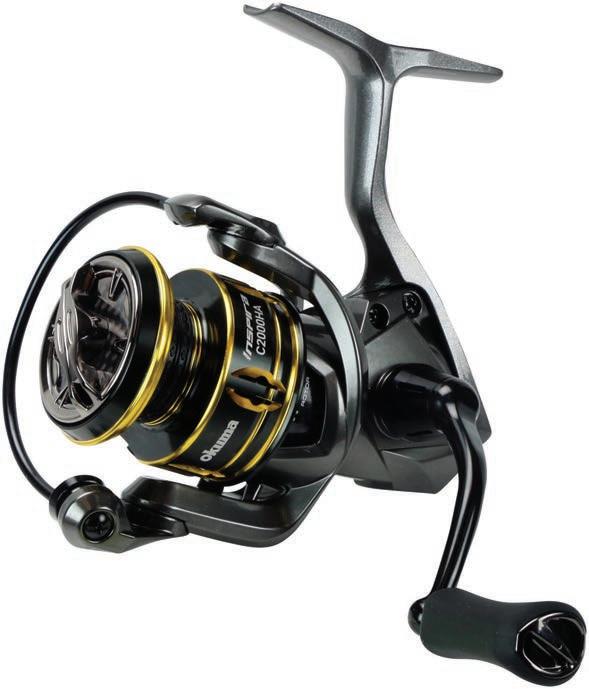
Okuma has raised the bar with the Inspira ISX “A” Spinning Reel. Delivering exceptional stability, smoothness, and power, our cutting-edge technology is sure to be a game-changer for anglers everywhere.
The ISX’s body is constructed from Okuma’s Torsion Control Armor (TCA) technology to provide greater torsion and flex resistance. Inspira ISX “A” also boasts Okuma’s Proprietary Flite Drive that enhances gear stability and smoothness. The multi-disc Carbonite and stainless-steel drag washer system, along with 8BB+1RB stainless steel bearings ensures smoothness, while the Quick-Set anti-reverse enables sure hooksets.
Beginning at 7.1 ounces, the Inspira ISX “A” delivers up to 24-lbs of maximum drag, while oversized HDGII main gear with machine-cut brass pinion ensures supreme reliability. Inspira ISX spinning reels are backed by a 1-Year Limited Warranty. MSRP $99.99 to $104.99.
www.OkumaFishingUSA.com
Berkley Cutter 90
Whether in the marsh or wading the flats for redfish, spotted seatrout, or snook; the Berkley Cutter 90 is designed to deliver explosive action. Berkley developed the Cutter 90 Saltwater to imitate small baitfish found in all coastal waters. The classic jerkbait shape delivers erratic rolling action and flash, coupled with a shallow-pitched bill for targeting fish higher in the water column. Berkley saltwater hardbaits feature stainless-steel hardware with Berkley’s ultra-sharp 3X Anti-Rust Fusion19™ hooks for long-lasting durability.
Berkley Cutter 90 Key Features:
• 90MM | 3.5IN
• 1/2 OZ
• Depth 3’ - 5’
• Available in 14 colors
(MSRP $9.99)
www.Berkley-Fishing.com/cutter-saltwater-1573531
PRODUCTS
TSFMAG.com | 61
Matagorda
THE VIEW FROM Matagorda
By now you are probably sweating profusely in the July heat. I love it –summer in Texas. Yeah, the boiling temperatures and draining days get old, but it is what I have known all my life. If you can endure our blistering summers, fall is only a weak cold front away.
A recent study determined that the population of Texas is growing at the rate of 1300 new legal citizens a day. Our population is booming and our bays will continue to see more and more anglers. And, that’s OK, just as long as we release a lot more than we take.
Telephone 979-241-1705
Email binkgrimes@yahoo.com
Website matagordasunriselodge.com

Our summer fishing in the Matagorda Bays has its ups and downs. More ups than downs, though, so long as southwest winds don’t linger too long. July has a tendency to provide lower than normal tides; southwest winds play a role in this. However, July also has a partiality to light winds that often give us a calm, green surf.
The good news is our fishing has been very encouraging for most of 2023. We are enjoying the fruits of our conservation labor since the Freeze of 2021. Still, we have to do more. It seems that much of the rah-rah displayed on social media to make our fishery better after that massive killing freeze has been forgotten. Not by all, mind you, just those slinging dead fish pictures across internet bandwidth to encourage prospective clients to purchase a date.
We have done so much to bring our fishery back from the dark days of that deadly freeze, only to forget our goal when better quality speckled trout begin to show more regularly. I put most of the blame on our charter captain industry. We are the pros, but some of us are acting like amateurs. We have to be the beacon of light and promote the balance of give and take of our fishery.
We know that fewer trout hitting the ice can do nothing but improve the quality of our catches. It has been proven during the past two years. Ask Matagorda captains, ask Baffin Bay captainsCatch and Release Works!

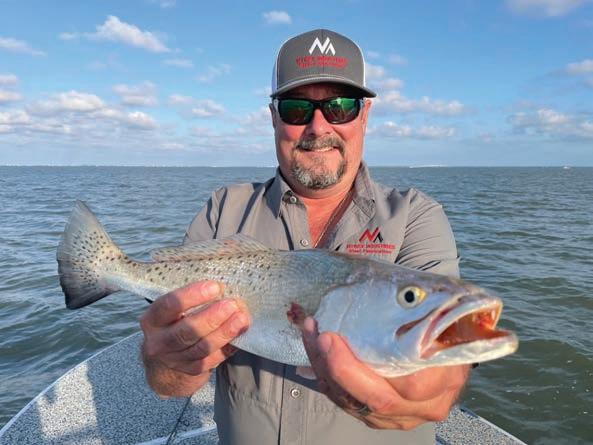
Honestly, I didn’t believe our fishery could bounce back this fast with only eighteen months of reducing daily bag limits and increasing the keep-slot lengths. It has been a joy to regularly release two-pound, 16.5 inch trout back to Matagorda Bay, knowing we all are responsible for better trout in our bays.
Several times in June we have caught and released easy limits of trout while drifting with soft plastics. You may say, “that’s no big deal.” Well, actually, it is a big deal. It tells me a whole lot about the state of our fishery. During the decade prior to the ’21 Freeze, it became increasingly difficult to catch trout on lures in East Matagorda once water temperatures rose above 75°. What we experienced in June tells me we have more fish today than we did back then.
We enjoyed this kind of catches in the 90s and early 2000s. Then, I believe, we began to overfish our resource and the results of our catches proved it. Hence, bag limits dropped from 10 to 5, and now down to 3. It is pretty simple to me – we control our own destiny. Yeah, I love eating trout, but I love catching bigger trout on topwaters and releasing them back to the bay a whole lot more than hot grease.
It is time for guides and outfitters to step up and do the right thing. Step up, be a professional. Quit selling fish. Sell a great time, sell customer service. Sell a how-to-become-a-better angler type of outing. Sell a safe, happy, family-friendly morning on one of Texas’ greatest natural resources. It is just good business.
If we keep debiting our account we are going to go broke.
Sunrise Lodge and Properties specializes in fishing, hunting, vacation rentals and coastal real estate. We would be happy to offer any advice that might help you enjoy Matagorda.
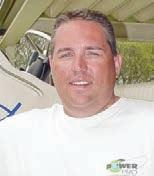 Bink Grimes is a full-time fishing and hunting guide, freelance writer and photographer, and owner of Sunrise Lodge on Matagorda Bay.
Bink Grimes is a full-time fishing and hunting guide, freelance writer and photographer, and owner of Sunrise Lodge on Matagorda Bay.
BINK GRIMES
The
Gonna Hot in Matagorda: Weatherwise and Fishing! 62 | July 2023
View
Video Open Camera and hover over QR Code. When link appears at top of screen tap to open in YouTube. July’s


TSFMAG.com | 63
Captain Shellie Gray was born in Port Lavaca and has been guiding in the Seadrift/ Port O’Connor area full time for the past 19 years. Shellie specializes in wading for trout and redfish year round with artificial lures.


Telephone 361-785-6708
MID-COAST BAYS With the Grays
I’m not sure how summer arrived so quickly, but it’s here; whether we’re ready for it or not. As the years pass I have to say that I have grown to prefer the cooler months much more than the hotter ones. By hot, I’m talking July and August. These months bring their own special set of fishing challenges, many of which can be overcome by packing plenty of patience and getting an early start.
With the abundance of rainfall the past several months, I am happy to say our Mid-Coast Bays remain healthy with only the areas closest to the river mouths being fresher than normal. Hopefully we won’t get a repeat of 2021, when San Antonio Bay became almost completely inundated and remained so nearly the rest of the year.
baits – the weedless gold spoon. Spoons cast like bullets and require little effort to present effectively. I prefer the 1/2-ounce spoon over the 1/4-ounce, for ease of casting and also because the hooks are stronger.
If by chance your reel is spooled with monofilament, it is imperative to rig with a quality barrel swivel to eliminate line twist that often occurs when retrieving this lure. Braided line has virtually no memory, so line twist isn’t nearly so troublesome. I do, however, recommend a heavy mono or fluorocarbon leader between the braid and the lure – if for no other reason than to reduce the visibility of the line.
The spoons and lots of patience produced some great redfish bites for the ladies, including a personal best specimen for Whitney Daws. I’m pretty sure she is sold on the spoon and will keep one in her wade box from here on out.
Email bayrats@tisd.net
Website www.bayrat.com
Facebook @captsgaryandshelliegray
If you are fond of sleeping late, July may be a tough month for you to be as successful as you might have been in the cooler months. With afternoon temperatures reaching close to 100° most days, the coolest part of the day is usually when the fish tend to feed more aggressively. I prefer to be on the water at least an hour before sunrise to take advantage of the overnight cooling.
I still prefer my trusty Bass Assassin 4-inch Sea Shad of various colors depending on water clarity, but whenever I see lots of morning surface activity I’ll likely opt for a small topwater like the Super Spook Jr., in either clear or bone color. Most July mornings will be quite calm so, even though I love my She Dogs and He Dogs, a smaller and less obnoxious floater will usually draw more strikes.
I had the exceptional pleasure recently to guide four accomplished women anglers for two days of wade fishing. Like most anglers, they don’t get on the water as often as they would like, and it was refreshing for me when they mentioned it would be mostly a catch and release trip, with only one of the ladies wanting a few for dinner. I love all my clients and appreciate a good fish dinner from time to time, but I would be lying if didn’t say how much I enjoyed these ladies’ attitudes toward conservation. Their appreciation of each catch was such a delight to witness.

In my 21 years of guiding, I often get so focused on producing bites that I sometimes forget to enjoy the other more relaxing aspects of fishing. The conversations with this group was a joy and covered topics from hair and clothing, to types of yummy desserts, and talks of places we’d like to spend a vacation. Quite often we’d be interrupted with a loud, “Woo-Hoo, I got another one,” as one of the group hooked up. We also discussed a range of fishing topics, such as types of structure and lure selection. I also want to compliment them on their patience. Patience is never more important than during these hottest months. While wading an area with thick bottom grass between sandy guts, I enjoyed coaching two of the ladies to use one of the best “forgotten”
So, the takeaway for fishing success in July is getting a very early start and packing plenty of patience. If you find an area that is holding a few fish, stick with it. Summertime water sometimes gets a bit crowded, which can limit options on other places to try. If the area you are fishing is giving up a few fish, rather than running around and looking for another spot, just be patient. Take a break, and then wade through it again. You may get a pleasant surprise.
CAPT. SHELLIE GRAY
Port O'Connor Seadrift
Thank you Whitney Daws, Andrea Wilson, Magen Besancon, and Chelsy Williams for two refreshingly fun days on the water.
64 | July 2023
Whitney Daws is now a big fan of the good ol’ weedless spoon!


TSFMAG.com | 65
Upper Laguna/ Baffin
HOOKED UP WITH Rowsey
Hope this finds everyone in the midst of whatever makes summer special to you. If you are reading this article, it probably has something to do with trout fishing. I can’t think of any place I’d rather be than waist-deep, staying cool, on a warm summer day.
David Rowsey has 30 years in Baffin and Upper Laguna Madre; trophy trout with artificial lures is his specialty. David has a great passion for conservation and encourages catch and release of trophy fish.
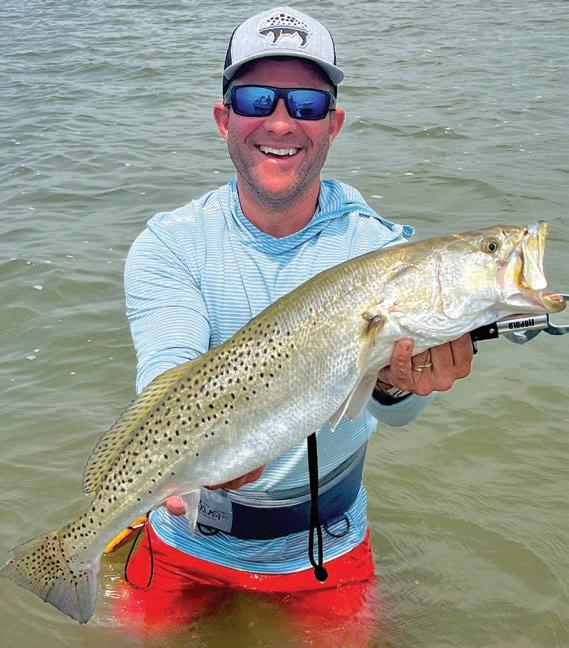

Telephone 361-960-0340
Website


www.DavidRowsey.com
Email david.rowsey@yahoo.com
If you are an angler that judges the day by how many bites you get, you need to be in the water right now. Pretty much every stop has a ton of action. Albeit the majority are small trout, with some solid low-20s. Being that it’s Baffin Bay, that can all change in an instant, and in the middle of catching smaller fish almost every cast.
I don’t care how long you have been doing it or what your experience level is, getting the hit and setting the hook feels just the same on big or small trout; it’s just good clean fun. Granted, you know pretty quickly after the hookset what it is, and your adrenaline fluctuates according to the resistance at the other end of your Waterloo. But, the bite and hookset is always treated like Ol’ Big is at the other end. The most important thing is that you are where you were born to be and enjoying the sport of fishing.
ever talk about (although I pray for it idling out of Bluffs Landing Marina every morning). Outside of that, putting clients in position to have a lot of chances and enjoying a full day on the water is paramount. We start our days very early around here, usually the first boat in Baffin or not far behind some other anxious angler/guide. We beat up on the trout pretty hard for about four hours, and around 10:00 I give the clients the option of continuing fishing for trout, that are likely not going to be as active for the rest of the day, or getting set up to do some sight-casting. Most opt for sight-casting, which is great by me, as it is what gets my adrenaline up more than anything else. The perfect combination of hunting and fishing. Of course, I’m always looking for that big, rogue trout in calf-deep water. But there are so many other sightings in that process and, frankly, easier targets. Redfish and drum can be spotted at surprising great distances to the trained eye, and easy enough to point out to clients who aren’t quite sure. The wary trout can be pretty tough in the beginning, until you learn what you’re looking for. A good day is catching one out five that you see, but what you learn about trout in the process, visually confirming how they react to lures, movement, shadows, etc., can be game-changing for the angler who aspires to be on another level.
Remember the buffalo! -Capt David Rowsey
@captdavidrowsey
We are well beyond spring’s blistering winds and most mornings now include slack wind scenarios. This makes for comfortable boat rides to your first wade, but these conditions are almost as tough as 30 mph sustained. If you’re fishing the Upper Laguna or Baffin, just keep in mind that our water currents are almost exclusively wind-driven. Without a little breeze and chop on the water, there is almost zero current to push bait into predictable areas for trout to set up to feed.
Slack wind days can be very tough on the angler, even when you know for certain you are standing right on top of them. I mention this, only because I have to relay it to clients on a daily basis. I’m sure some think it’s just “guide talk” but I’m vindicated just about every time when the wind kicks up to 10 mph and the trout start biting almost instantly. It truly happens daily, so don’t be too hard on yourself if you find yourself in this scenario and things aren’t working out so good for that buddy you are trying to impress. Just wait it out, be patient, things will change as sure as the wind is bound to blow in Corpus Christi.
Writing a monthly column year after year, you are sure to hear me mention the same or similar things on the same month each season. Honestly, it can become a bit monotonous, but that is also the same with chasing trout in any given month, considering that the major variables are water temperature, bait supply, stage of spawn, length of sunshine in a day, etc. Saying that, there are also a bunch of little variables that guys like me must keep an eye on during a charter. Safety is always number one, but that is a given and one we hardly
DAVID ROWSEY
View The Video Open Camera and hover over QR Code. When link appears at top of screen tap to open in YouTube.
66 | July 2023
Doug Opalka with a 29-inch trout that fell for a Bass Assassin during a midday minor. Released for another angler to enjoy and to spawn again, and again.
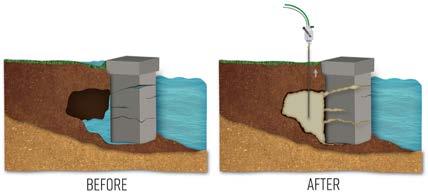






catfoam.com 1-800-595-1880 Fast/Affordable Risk Mitigation No Heavy Equipment Convenient Environmentally Friendly Benefits: Porches & Stoops Driveways Sidewalks Pool Decks & Patios Bulkhead & Seawall Repair The Deep Foamjection™ process will create a solid barrier preventing future erosion and degradation of sea wall/ bulkhead sub structure. Before Concrete Lifting: Drill. Pump. Patch. TSFMAG.com | 67
Port Mansfield
WAYNE’S Mansfield Report
Telephone 210-287-3877
Email captwayne@kwigglers.com

Greetings from Port Mansfield! Well, we just blew through Memorial Weekend, the traditional launch pad for summertime fun and fishing, which also includes the kickoff of the annual CCA STAR Tournament. I was invited to participate in this year’s release of STAR tagged redfish here in the Lower Laguna Madre and greatly appreciated the opportunity. The STAR committee arranged for us to receive the tagged fish, some wearing red tags and some blue. The red tags representing the traditional Tagged Redfish Division and the blue-tagged redfish taking the place of the former Speckled Trout Division. Kudos to CCA on dropping that division.
Transferring the tagged fish from holding tanks to my SCB Recon, the instructions from the STAR representative were simple and straight forward. “Release the fish in popular, highly-populated fishing areas,” which was exactly what Javier Suarez (director of CCA RGV Chapter) and I did. I would highly recommend if you’re not already signed up for STAR that you do so immediately before going fishing again. I guarantee there are quite a few tagged redfish swimming in highly-populated fishing areas of the Lower Laguna Madre. Activate the accompanying QR code to learn how to report the landing of a STAR tagged redfish.
The waters of Port Mansfield are in great shape and the abundance of bait is as good as I have ever seen. Our trout fishery is recovering nicely with good numbers of upper-slot and larger fish being caught regularly. I am seeing and hearing from other guides the abundance of trout measuring just short of the 17- to 23-inch slot length and I will offer a comment on that. If you recall, well before the post-freeze regulations were enacted, these same people were reporting an abundance of 14.75-inch trout being caught all the time. So what’s the takeaway? Pretty easy, I’d say. “There will always be a great number of fish caught that measure just shy of the minimum retention size, no matter what that size might be at any given time.” Perhaps not the most science-based answer but the observation of a guide who spends a lot of time on the water. Think about it.
Redfish landings have waned a bit recently. We’re still catching some but definitely fewer compared to recent months. We are also noticing recent landings weighing mostly in the 5- to 7-pound range with a 7-plus considered “heavy” at present. My thoughts are that you can catch a few good ones shallow in early morning, and then as the day progresses they migrate to deeper water where they are less likely to get run over by boats running the shallow flats.
Flounder landings are just now starting to pop. A few months back
we were seeing better numbers, and then it became a challenge to find them in any of the usual places. As recent as a few days ago, it seems they have begun reappearing and their weights are impressive. I’ve seen a couple four-pounders coming to the scales in local tournaments.
Another recent development is the floating grass – it’s back and in good supply. Anglers headed this way would do well to rig surface lures with single hooks to combat the problem.

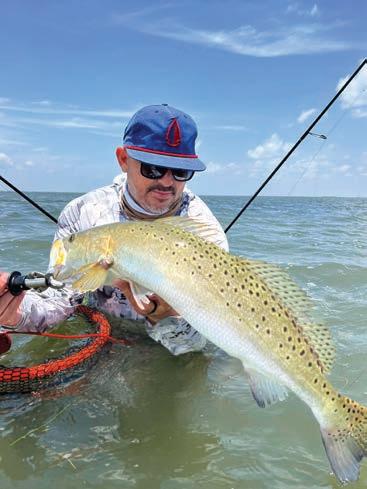
Currently, my game plans include variable approaches based on both low and high tide levels, as well as wind of varying strengths. If it’s high water with high wind, I have been targeting back-bay flats with emphasis on points and drains within those areas. Topwater action can be very good so long as the surface isn’t clogged with floating grass. The Mansfield Knockers folks have been putting in a lot of work and I have really come to like their lures based on size, shape, noise and castability. Most importantly, fish seem to like them.
With low water and calm wind conditions, I will be targeting just outside those back-bay flats and will usually set my folks up covering both points and one or two in the middle. I’ll also be working stretches of shorelines and spoil islands. Carrying two rods, I can easily switch from my Mansfield Knocker to KWigglers Wig-A-Lo, Paddle Tail, or BTS set up. I typically bounce back and forth all day in effort to stay on top of the feeding patterns as they emerge.

Keep in mind we also have excellent offshore stuff going on. Lots of red snapper coming in on the regular.
Mark your calendars for the 48th Annual Port Mansfield Fishing Tournament: July 27-29, 2023. I know it is going to be a big event with excellent prizes and big payouts. Hope to see you there.
Remember, fresh is better than frozen…
View The Video
Open Camera and hover over QR Code. When link appears at top of screen tap to open in YouTube.
Captain Wayne Davis has been fishing the Lower Laguna-Port Mansfield for over 20 years. He specializes in wade fishing with lures.
DAVIS
WAYNE
Rob Harrison scored this earlysummer sixpounder with a topwater on a recent charter.
68 | July 2023
Jake Gomez used an old-school 4-inch red and white KWigglers paddletail to trick this fine trout.



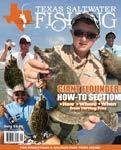
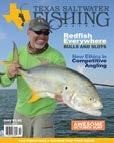


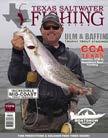
Auto Renewal available with all subscriptions! GET FREE E-MAG WITH HARDCOPY PURCHASE! Order today and receive a 12-month subscription for $32.00. Hurry and sign up family members and/or friends at the same rate! AM EX 361-785-3420 Monday – Friday 7:30 a.m. – 4:30 p.m. To order subscriptions simply fill this form out below & mail it to the address below, fax, email or go online. SUBSCRIPTION FORM SUB0723 Subscribing for more than yourself? Please write additional information on a separate sheet of paper. 12 months print - $32.00 12 months digital only - $15.00 24 months print - $56.00 361-792-4530 TSFMAG.com | 69
Cell 956-266-6454
Website www.tightlinescharters.com

SOUTH PADRE Fishing Scene
Putting this article together, I’m wearing a big smile and couldn’t be happier with the quality of fishing we have been experiencing lately on the Lower Laguna Madre. Despite busy waterways, especially on weekends, the fish are where we expect them to be. Deeper waters, such as the Brazos Santiago Pass, have also come alive with tarpon, kingfish, jack crevalle, oversized reds, snook, and Spanish mackerel. I don’t usually venture out that way but the action has been so good I just had to join in on the fun.

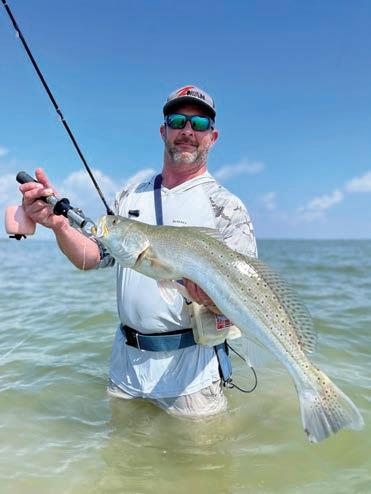

Meanwhile, in the bays, the fishing has also been consistently good. Hopefully, it will continue to remain so as we enter the hottest season of the year. Wind in July is usually either light or barely a breeze, especially in early morning. Dead calm can sometimes make fish wary, and difficult to get them to bite. Constantly alert, they can sense danger from a long way off. This is where wading offers distinct advantages, but stealth is the byword. One small misstep and they’re gone.
Early to mid-morning will be optimal for targeting fish up shallow. After that, change your tactics to deeper, cooler water. When water temps reach the 90s I switch focus to drop-offs along the ICW and similarly deeper areas within our bays. Having a means of measuring water temperature is crucial in helping you locate cooler water that could be holding fish during the hottest periods of the day.
Let’s talk about summertime redfish. Redfish can tolerate surprisingly warm water and I have found plenty of them over the years, even in areas with water temps rising into the high-90s. I can recall finding them in deeper areas of the flats, stacked like breakfast pancakes. Redfish tailing action will often occur in the coolness as the sun is rising, as redfish grub bottom for small crabs and shrimp. The waving of a spotted tail above the surface is a sign you can’t miss, and when they are busy with their nose down and tail up, it’s easier to get up close and personal, if you can wade quietly. No time for a surface lure, think soft plastic, maybe a Z-Man Kicker CrabZ on a lighter jighead. If you’re lucky, you can sometimes run into pods of tailing reds. When targeting pods, try to pull the hooked fish as swiftly and quietly as possible away from the group to avoid spooking the others.
The state of our trout fishery is the main reason for my big smile the past couple of weeks. While we’re still not seeing many in the 8-plus trophy category, a surprising number of 4- to 7-pounders are being
landed regularly by my clients. There have been days that gave us a solid three-hour bite, and on topwaters at that. Of course, there are still lots of little ones in the mix, so please handle them carefully.
Areas to target in July will be potholes early in the day, then the edges of the ICW, and other deeper water. By deeper, I mean anything in the four- to six-foot range. Z-Man’s PaddlerZ, DieZel MinnowZ, and Streakz will continue to be productive this summer. Three of my favorite colors are Pearl, Redbone, and Sexy Penny. Slicks will continue to be a primary indicator of trout feeding activity in July, use your nose and eyes accordingly.
One last trout tip: Work the edges of the ICW when conditions become slick-calm. Cast deep into mid-channel and retrieve your lure slowly. If this doesn’t draw a strike, throw along the drop-off and work your bait parallel to the edge. Varying between these two techniques as the tide moves in or out should bring you plenty of action this summer.
Snook fishing will be in full swing this month and, from what I have seen thus far, I expect some very good days ahead. Snook tend to feed more actively during periods of strong tidal movement, so two-tide days are often the best to target. Make sure your leader is fluorocarbon and at least twenty-five-pound test. Snook love topwaters and I highly recommend strong, single hooks. ZMan StreakZ in Pearl color would be my first pick of soft plastics.
Flounder are finally beginning to show in the usual places. We are not experiencing the large numbers we saw two and three years ago, but there are some for the catching along the ICW, old oilfield channels, and the East Cut, to name a few places you might try.
I’m excited and hope you are, too. Please be courteous to your fellow anglers and practice good conservation.
View The Video Open Camera and hover over QR Code. When link appears at top of screen tap to open in YouTube.
A Brownsville-area native, Capt. Ernest Cisneros fishes the Lower Laguna Madre from Port Mansfield to Port Isabel. Ernest specializes in wading and poled skiff adventures for snook, trout, and redfish.
CISNEROS
Arroyo Colorado to Port Isabel CAPT. ERNEST
Chris Gwyn tricked this one on a ZMan PaddlerZ - Sexy Penny.
70 | July 2023
Solid early-summer trout for Ryan Trotti.
The C.A.L. family of lures offer a wide variety of lure shapes for both freshwater and saltwater fishing. From small ponds to deep jigging ocean reefs, D.O.A. has you covered.

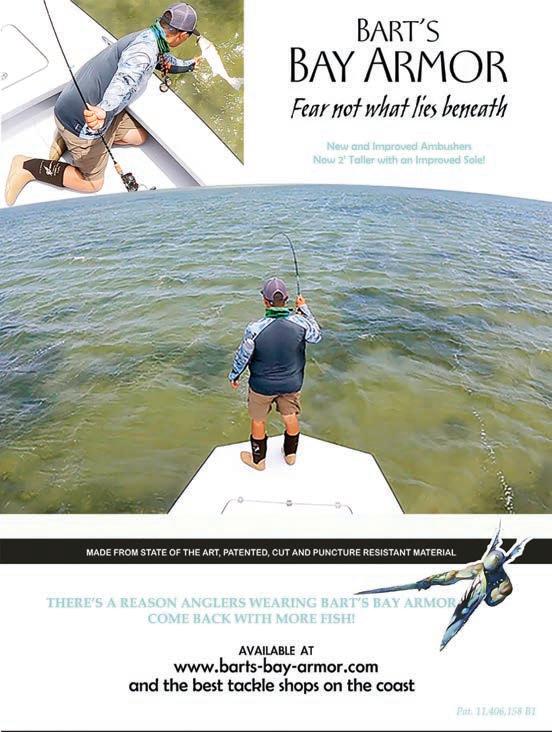

Made from tough soft plastic, each lure is made to match up perfectly to D.O.A. short and long shank jig heads.
www. doa lures.com
 Made in USA
C.A.L. 5” Swim Bait
C.A.L. 4” Shad Tail
C.A.L. 3” Shad Tail
C.A.L. 4” Jerk Bait
C.A.L. 5.5” Jerk Bait
C.A.L. Paddle Tail
Made in USA
C.A.L. 5” Swim Bait
C.A.L. 4” Shad Tail
C.A.L. 3” Shad Tail
C.A.L. 4” Jerk Bait
C.A.L. 5.5” Jerk Bait
C.A.L. Paddle Tail
221981_DOA_10.5_TxSF_CAL Family_3.685 x 4.875.indd 1 10/5/22 2:34 PM TSFMAG.com | 71
C.A.L. Curl Tail
FISHING REPORTS AND FORECASTS from Big Lake to Boca Chica

Trinity Bay - East Bay - Galveston Bay | James Plaag
Silver King Adventures - silverkingadventures.com - 409.935.7242
James said the fishing on trips in the few weeks prior to giving this report reminded him of the old days. “We’ve been catchin’ ‘em wading and out of the boat, in multiple places. Big numbers of solid keeper trout, most running from about two and a half to around four pounds. My numbers this year compared to last year are up about 75%. The topwater bite has been great at times, and not only when we’re wading. We’ve been fishing some humps in deep water which produce a great topwater bite during parts of the tide cycle. Overall, the catching has been better on soft plastics, though. We’re doing our best lately on two specific lures, the Lil’ John in clear with a chartreuse tail and the natural-looking Assassin Sea Shad. So long as we continue to have nice weather, meaning winds stay light a good portion of the time, we’ll continue to have excellent catching. The fishing along the channel is perking up already, and that action typically stays steady well into the heat wave at the peak of summer. If we continue to have salty water in Trinity Bay, some of those fish might move up that way.”
Jimmy West | Bolivar Guide Service - 409.996.3054
Like many others who submitted reports for this issue, Jim mentions excellent fishing on numerous trips over recent days and weeks. “We had a really fun run in the surf when the wind calmed down. At first, the topwater bite was hot and heavy, and we were able to catch plenty of solid keeper trout in water less than about eighteen inches deep, in the first gut. Once the winds stayed light a bit longer, and the water became stupid clear, the bite got tougher, but we did keep catching at a pretty high rate. In that situation, a soft plastic which resembles a shrimp rigged on a sixteenth-ounce head works much better, ones with brown and some lighter tints. We’ve also had some great days catching trout out of the boat around the main reefs in East Bay. Out there, we’re throwing soft plastics more than topwaters, and the average size of the trout has gotten better, compared with earlier in the spring. On some days, the percentage of keeper trout running from two to about four pounds is outstanding. Slightly heavier jigheads have been working better when we’re fishing out of the boat, meaning we’re throwing mostly eighth-ounce ones.”
West Galveston - Bastrop - Christmas - Chocolate Bays
Randall Groves | Groves Guide Service
979.849.7019 - 979.864.9323
Different lures and strategies work best in different parts of the area around San Luis Pass lately, according to Randall. “We have had clouds of glass minnows roaming around in the shallows, and both the trout and redfish are following them. When we are working this pattern, we like to throw natural looking soft plastics like Norton Sand Eels to mimic the look of the minnows. Recently, with the calm winds, the bite in the surf has kicked off nicely. Out there, we see lots of mullet and other small fish, and topwaters with blue and chrome on them have worked well, especially early in the mornings. We tend to catch best close to the beach in this situation. Later in the mornings, the fish tend to stack up in the guts farther from the sand, and we catch ‘em better on Norton Sand Eels in colors like glow/chartreuse tail. When we’re fishing out of the boat in the deep water behind the pass, the shrimp have been most plentiful. In these places, Sand Eels in tequila gold have worked best, rigged on three-eighths ounce jigheads. Shout out to Sport Marine in Richmond, who are currently rigging my new boat.”
Matagorda Bays | Capt. Glenn Ging Glenn’s Guide Service - 979.479.1460
www.glennsguideservice.com
July is a great month for fishing around Matagorda, even despite the heat. We’ve already had a good bit of surf action this year, and we should see more in July. As the heat rises, look toward fishing areas with deeper water and higher current flows. The outside bars on the south shoreline of West Matagorda Bay and the deep scattered shell in East Matagorda Bay will be great options, as will the jetties. Look for increasing numbers of tripletail in West Matagorda Bay. Runoff from all the rain may continue to affect the back lakes and rivers, but they can become productive locations if the rain lets up. For people looking to beat the heat, nightfishing and floundering are great July options. Fishing with live shrimp under Coastal Corks will continue to produce through July, as will freelining live shrimp on the jetties and in deeper holes with good current flow. A long list of popular topwaters and soft plastics will also all be effective throughout the rest of summer. Bass Assassins in fried chicken and chicken on a chain color rigged on eighth-ounce jigheads have been producing well for me lately in both the bays and out in the surf.
Palacios | Capt. Aaron Wollam
www.palaciosguideservice.com - 979.240.8204
We are on probably the best two-week stretch of fishing I have seen since the big freeze of 2021. First off, the trout bite has been crazy good in multiple areas. We’ve been catching solid fish out at the rigs and deep reefs in West Matagorda Bay on Down South in white ice and live shrimp rigged about five feet under Coastal Corks. The surf has been on fire also, with upper-slot trout coming to hand on green/chrome and chartreuse/ chrome She Dogs. Lots of mullet have been in the surf, and the trout have been absolutely crushing topwaters at first light. The redfish/black drum bite has been just as good. Most any patch of shell on shorelines from the river to Hotel Point has been holding good solid keepers. Live shrimp rigged a foot under Coastal Corks and shrimp-flavored Fish Bites have been drawing lots of strikes. Flounder have become plentiful, with lots of 16 to 18” fish coming to the boat for the giggers. Tripletail in the ten-to-fifteen-pound class are finally showing up around structures after a cool spring. I look forward to one of the best summers in a long time with so much bait around.
Port O’Connor | Lynn Smith
Back Bay Guide Service - 361.935.6833
Lynn reported excellent action recently in the surf when we talked. “We’ve been catchin’ ‘em good in the surf lately. I was out there five days last week, and we did good every day. The topwater action has been steady. We’re throwing bright and shiny topwaters of all kinds and getting plenty of blow ups. This action should remain reliable any time we have lulls in the winds which last more than a day or two, all the way through the summer. When it’s windier, I’ll be moving into the bays, concentrating on areas close to the pass and/or the deeper channels. Right now, Lavaca Bay and areas up that way have been inundated with freshwater. This typically pushes some of the fish down toward Port O’Connor. When that happens, the flats close to deep water in this area produce excellent catching on topwaters early in the mornings, especially when the tide is coming in. Later in the days, the bite is often better on deep
72 | July 2023


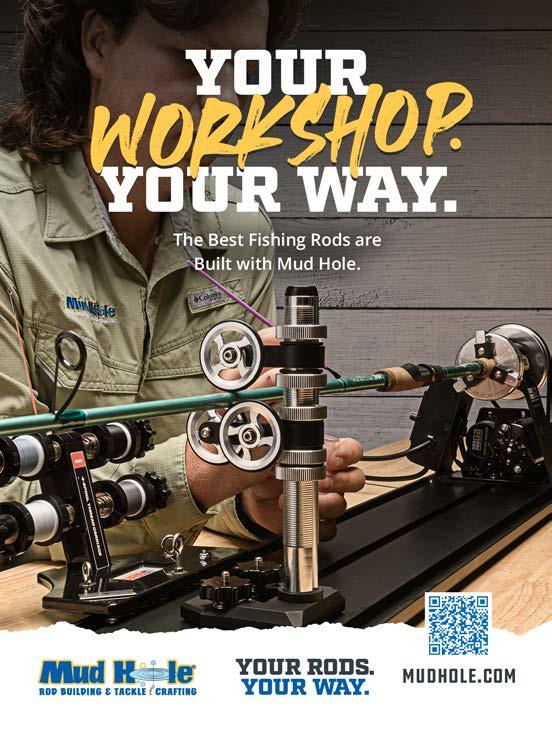



TSFMAG.com | 73
reefs and on the drop-offs from the shallows into the guts and channels. Then, the bite is usually better on soft plastics fished closer to the bottom on heavier jigheads if the winds and currents are strong.”
Rockport | Blake Muirhead
Gator Trout Guide Service - 361.790.5203 or 361.441.3894
Blake finds a wide variety of places productive for catching trout and redfish in the Coastal Bend bays during the month of July. “I will be looking to heading out into the surf as much as possible this month. When winds allow for fishing out there comfortably, the catching is usually good, especially for trout early in the mornings. We normally do well out there throwing topwaters. I also fish some of the mid-bay reefs in San Antonio, Mesquite, Aransas and Copano bays. When fishing the reefs, the bite is usually best on soft plastics and live croakers, though the topwaters do work well around the shell at times too. Both these patterns work best when winds are relatively light. If the winds are stronger, we normally find ourselves fishing sandy, grassy flats closer to shorelines, in water running pretty shallow, around knee-deep early in the mornings, and somewhat deeper, about as deep as we can wade, later in the days, once the sun heats up the water in the shallows. The reefs and the shorelines both hold good combinations of trout and redfish during the summer months, especially in areas which are holding thick concentrations of mullet.”
Upper Laguna Madre - Baffin Bay - Land Cut
Robert Zapata | rz1528@grandecom.net - 361.563.1160
The sizzling temperatures in July match the hot, fast action. This time of year, the trout and reds will move into the shallows late at night and stay there for a while in the mornings, while the water is at its coolest. We often find schools of reds on calm mornings while we’re running the boat across shallow flats. We can see them pushing wakes. When we do, we work upwind of the schools and move toward them with the trolling motor, making long casts to the outer edges of the schools once we’re close enough, to avoid spooking the fish. We target trout early in the mornings around rocks, sand bars and grassy edges, in water less than three feet deep. This is a great month for topwater action on lures like She Dogs in bright colors. But the action is often best on soft plastics rigged on light Springlock jigheads. Once the sun and temperatures rise later in the mornings, we catch more trout and reds in deeper water. As long as winds are light to moderate, we have great luck sight-casting for drum in water less than two feet deep during the middle of the days, throwing shrimp-flavored Fish Bites.
Corpus Christi | Joe Mendez - www.sightcast1.com - 361.877.1230
As the hot weather settles in and reaches a peak, fishing patterns in the Upper Laguna, Baffin Bay and Corpus Christi Bay normally work best in places with deep water lying close to shallow water. “During the heat of the summer, we do well fishing around rocks which lie close to the Intracoastal Waterway, or close to deep basins. Places which meet this description include the rocks on the Kenedy Ranch Shoreline south of Baffin, those lying along the ICW in that same area, and places like Center Rocks, Marker 9 rocks, and the outer portions of E Kleberg Rocks and Cathead. We also do well fishing the outer edges of the flats running off shorelines, close to the drop off into deeper water. Usually, we do best throwing soft plastics, matching the jighead size to the depth of the water and the conditions, meaning we use lighter heads when the water’s shallower and winds are lighter, heavier ones in deeper water and stronger winds and currents. We do still have good fishing in the shallows this time of year, especially for reds. We find them on shallow grassy flats early and are able to sight-cast some later in the days.”
P.I.N.S. Fishing Forecast | Eric Ozolins 361.877.3583 - Oceanepics.com


Surf fishing has been on fire! The trout bite on topwaters has been fast and steady, but they’re taking soft plastics and sinking MirrOlures too. This time of year, balls of baitfish form offshore, and some make it into the surf zone during the afternoon hours, creating feeding frenzies for predators like jack crevalle, Spanish mackerel, skipjacks, and tarpon. Throwing spoons or topwaters into the chaos usually makes for easy catching. Skipjacks aren’t edible but they are extremely fun to catch, especially on light tackle or fly. Shrimp and Fish Bites mostly wind up attracting whiting or hardhead catfish, however a pompano or drum is not out of the question. As we really get into offshore shrimp season in July, many of the smaller blacktip sharks will head offshore to work the culling shrimp boats. At the same time, the hot nights will be suitable for some monster tiger, bull, and hammerhead sharks to roam into the shallows. This time of year, we target the big sharks using big baits. Folks who deploy smaller shark baits, such as whiting, catch mostly scalloped hammerheads or giant rays. The mature southern and roughtail rays are abundant in the shallows, feeding on crustaceans and small fish.
Port Mansfield | Ruben Garza Snookdudecharters.com - 832.385.1431
Getaway Adventures Lodge - 956.944.4000
Topwater action is wide open right now. Most anglers will only fish topwaters in the first part of the morning, but this time of year, they often work well all day. Lately, the west shoreline has been producing the best; areas such as Century Point, the Little Mottes and shorelines north of Little Bay have been holding lots of fish. When the fish aren’t taking topwaters, the action has been better on KWiggler Ball-tail Shads in colors like Lagunaflauge, plum/chartreuse, Mansfield Margarita and Bart’s Bay Ninja, rigged on eighth-ounce screw-lock jigheads. The submerged spoil dumps up that way also have great potential in hot weather, as do areas around Dubb’s and Butcher’s islands. Down south, West Bay is always good, but fishing the Saucer behind the cabins is probably the best choice lately. On the really light wind days, Bennie’s Bar can produce fast catching. While topwater action has been great, some areas have a lot of floating grass. To cope with this, Mansfield Knockers offer single-hooked topwaters. Colors like Ruby Tuesday and Golden Croaker work great. On the east side, targeting redfish in water about mid-thigh depth has worked well later in the mornings. We’re catching them best on gold spoons.
Lower Laguna Madre - South Padre - Port Isabel
Aaron Cisneros | tightlinescharters.com - 956.639.1941
Fishing around South Padre Island has been excellent this spring, and the summer fishing looks promising too. Our best trout fishing lately has been in three to five feet of water, where we’re throwing at some of the grass beds in the deepest water. Finding bait is always a key to catching when fishing deeper water. ZMan StreakZ 3.5” Houdini rigged on quarterounce Trout Eye jigheads slowly jigged in close contact with the bottom have proven to work best on most trips. Topwaters of various types have worked well most days too, in the early-morning hours. The redfish have been biting well in the mornings too. We’re finding most of them on shallow shelves and flats adjacent to deeper water. Super Spook Jrs rigged with single hooks have produced bites at the highest rates. The redfish bite has been best when the wind picks up. They’ve been moving off the flats into deeper, off-colored water once the wind picks up. Four-inch ZMan DieZel Minnows in Redbone color rigged on eighth-ounce Redfish Eye jigheads have been a hot choice. We are looking forward to these patterns continuing to produce as the hot weather comes to stay for good.
74 | July 2023





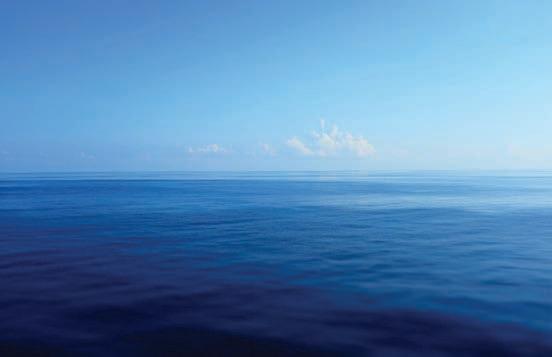

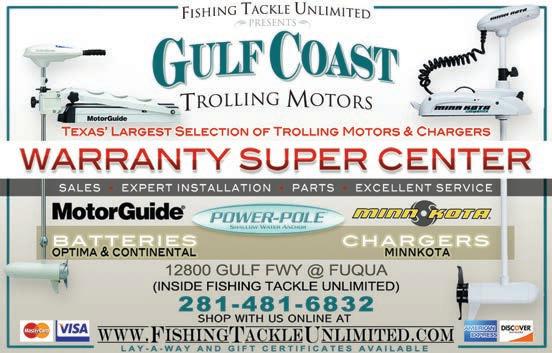
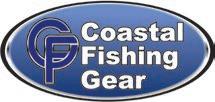




TEXAS SALTWATER FISHING HOLES USCG Licensed Captain Stan Sloan MATAGORDA BAY Speckled Trout / Redfish 832.693.4292 www.fishfcc.com Fin Tastic Coastal Charters Fishing Charters Galveston Offshore & Bay Full electronics & Bathroom. Included: bait, ice, ice water. Bring your own food and drink. Kingfish, Tuna, Mahi Mahi, Grouper, Snapper, Redfish, Flounder, Trout & more... 409-919-0833 | topgalvestoncharter.com Trips: 5,8,10,12 hours. Captain & Mate. Home of the & www.CoastalFishingGear.com | 281-736-6670 USE COUPON CODE TSFM15 FOR 15% OFF OF CFG ONLINE ORDERS Check out our YouTube Channel! TSFMAG.com | 75





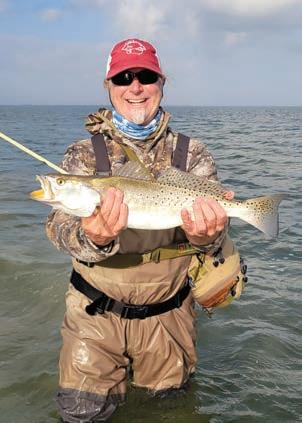
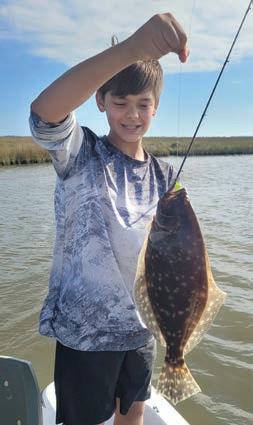

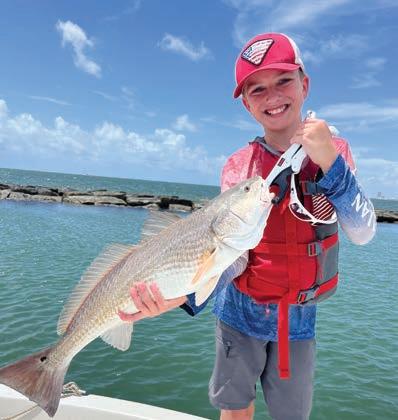

Brought To You By www.kingsailfishmounts.com
Noah Eidson Galveston North Jetty - 29” redfish
Joseph Zamora Brownsville - 29” black drum
Steven Herrera 27.5” 6 lb personal best trout!
Miodrag Lazic 38” personal best redfish!
Robert Hale Port Mansfield - trout
Matt Williams Port Mansfield - trout
76 | July 2023
Tristan Souza Sabine Pass - flounder
Photo Gallery Guidelines

First come – first published! Photos are judged on artistic merit and sporting ethic displayed. No stringer, cleaning table, or hanging board images allowed. Digital images only. Adjust camera to high or best quality. All images become property of TSFMag. Email to: Photos@TSFMag.com Include short description of your catch with name, date, bay system, etc.

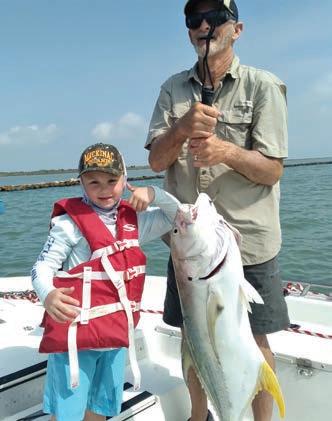





 Ellis Halverson East Matagorda Bay - first trout!
Ben Lalumia with Bobby Ward Mesquite Bay - first jack!
Theo McCollum, Jr. Galveston Bay - 4 lb black drum, first catch!
Cal Bowers Port Mansfield - trout
Maddie Goodrich Shoalwater Bay - 25” red
Joel Carter Port Mansfield - trout
Mark Mullin 40” red while wade fishing
Ellis Halverson East Matagorda Bay - first trout!
Ben Lalumia with Bobby Ward Mesquite Bay - first jack!
Theo McCollum, Jr. Galveston Bay - 4 lb black drum, first catch!
Cal Bowers Port Mansfield - trout
Maddie Goodrich Shoalwater Bay - 25” red
Joel Carter Port Mansfield - trout
Mark Mullin 40” red while wade fishing
TSFMAG.com | 77
Ljubomir Lazic 33” personal best black drum!
Got ideas, hints or recipes you’d like to share?


Email them to pam@tsfmag.com or send by fax: 361 792-4530

Gulf Coast
Ranchero Snapper Ceviche
INGREDIENTS
1 cup of cubed fresh snapper
¼ cup finely chopped onions
2 limes squeezed
½ cup sliced cucumber
½ cup chopped carrots
½ cup diced tomatoes
¼ cup chopped cilantro
1 finely chopped jalapeno
1 tsp Julio’s seasoning
¼ tsp crushed red pepper (optional)
PREPARATION
Place cubed snapper in glass bowl and cover with onions and lime juice. Place in refrigerator and let set for at least 4 hours or longer.
Mix veggies and seasoning together, cover with plastic wrap and place in refrigerator until fish is ready to combine. Add fish to veggie and seasoning mixture toss to combine. Serve with Julio’s corn chips!

Cabo San Lucas Snapper Ceviche
INGREDIENTS
1 cup of cubed fresh snapper
2 limes squeezed
½ cup cubed mango
½ cup sliced red grapes
½ cup diced avocado
¼ cup chopped cilantro

1 finely chopped jalapeno
1 tsp Julio’s seasoning


PREPARATION
Place cubed snapper in glass bowl and cover with lime juice. Place in refrigerator and let set for at least 4 hours or longer.
Mix mango, grapes, avocado, cilantro, jalapeno and seasoning together; cover with plastic food wrap and place in refrigerator until fish is ready to combine. Add fish to seasoned fruit and veggie mixture, toss to combine. Serve with Julio’s corn chips!
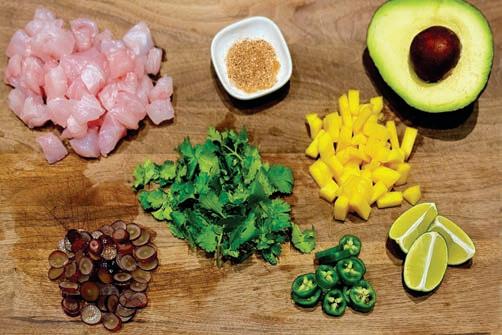

PAM JOHNSON
78 | July 2023
Shake it up with Julio’s!


TSFMAG.com | 79 FIRST RESPONDERS ACTIVE MILITARY RETIRED MILITARY THANK YOU! FOR ALL THAT YOU DO HAPPY 4TH OF JULY! JULIOSCORNCHIPS.COM
Summer is in full swing and boat services are in high demand!
and would appreciate getting the boat back in time for the outing.
We used to encourage dropping the boat off. We had to stop; simply because we would sometimes have more than 100 boats on the property at any given time and the responsibility was too great.


Today we work by scheduling appointments as much as possible, while trying to take care of emergencies as they occur.
“What can we do for you?”

My goal in writing this month is to increase owner awareness of the heightened seasonal demand for boat repair and maintenance services, and also to ask that owners kindly allow their service providers the greatest opportunity to assist them in all the best ways possible. Summertime demand can be enormous, and we truly want to help you. It is our mission and responsibility to help you. So, let’s look at some of the ways you can help us accomplish this.

The top three service items currently in greatest demand originate from boats sitting in storage during off-season – customers seeking annual service to get the family on the water – and, of course, all the normal breakdowns.

The calls for these services frequently request dropping off this week, pick up next week, or within two weeks.

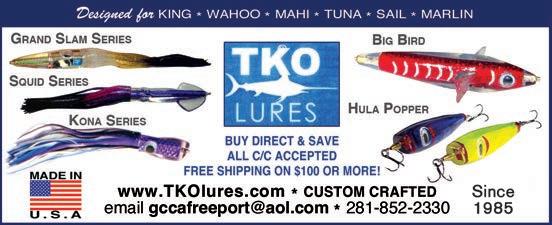
The hardest thing to say is, No…or Sorry, we cannot get to the boat that quickly. The customer often indicates they have family coming in
Leaving boats in open lots or fields invites boats full of rainwater and other damage – broken jacks and taillights, dead batteries, flat tires, etc.
You, the customer, are the most important part of our business and, as business owners, we truly want to help you. Please help us help you by allowing as much time as possible for preventative maintenance during the pre-season, and give as much notice as possible when needing a problem solved. We are always glad to help!
Have a great summer season!

CHRIS MAPP REPAIR & MAINTENANCE
Chris Mapp, owner of Coastal Bend Marine and Flats Cat Boat Company. Great Service, Parts & Sales.
Chris Mapp Coastal Bend Marine | Port O’Connor, TX 361-983-4841 | chrismapp@coastalbendmarine.com PESCADO PARK RV PADS & BOAT STORAGE Baffin Bay near Kaufer-Hubert Boat Ramp DAN WARD 832-860-4600 dwpb@comcast.net
Capt. Lynn Smith’s Back Bay Guide Service Port O’Connor Area TROUT REDFISH FLOUNDER Wade & Drifting the Back Bays & Surf Call 361.983.4434 (cell 361.935.6833) Email lynn@tisd.net (tswf.com/lynnsmith) 80 | July 2023
SUMMERTIME DEMAND

www.scbboats.com A DIVISION OF 956-233-9489 ® 10YEAR HULL WARRANTY BACKED WITH OUR ® DESIGN YOUR SCB ONLINE
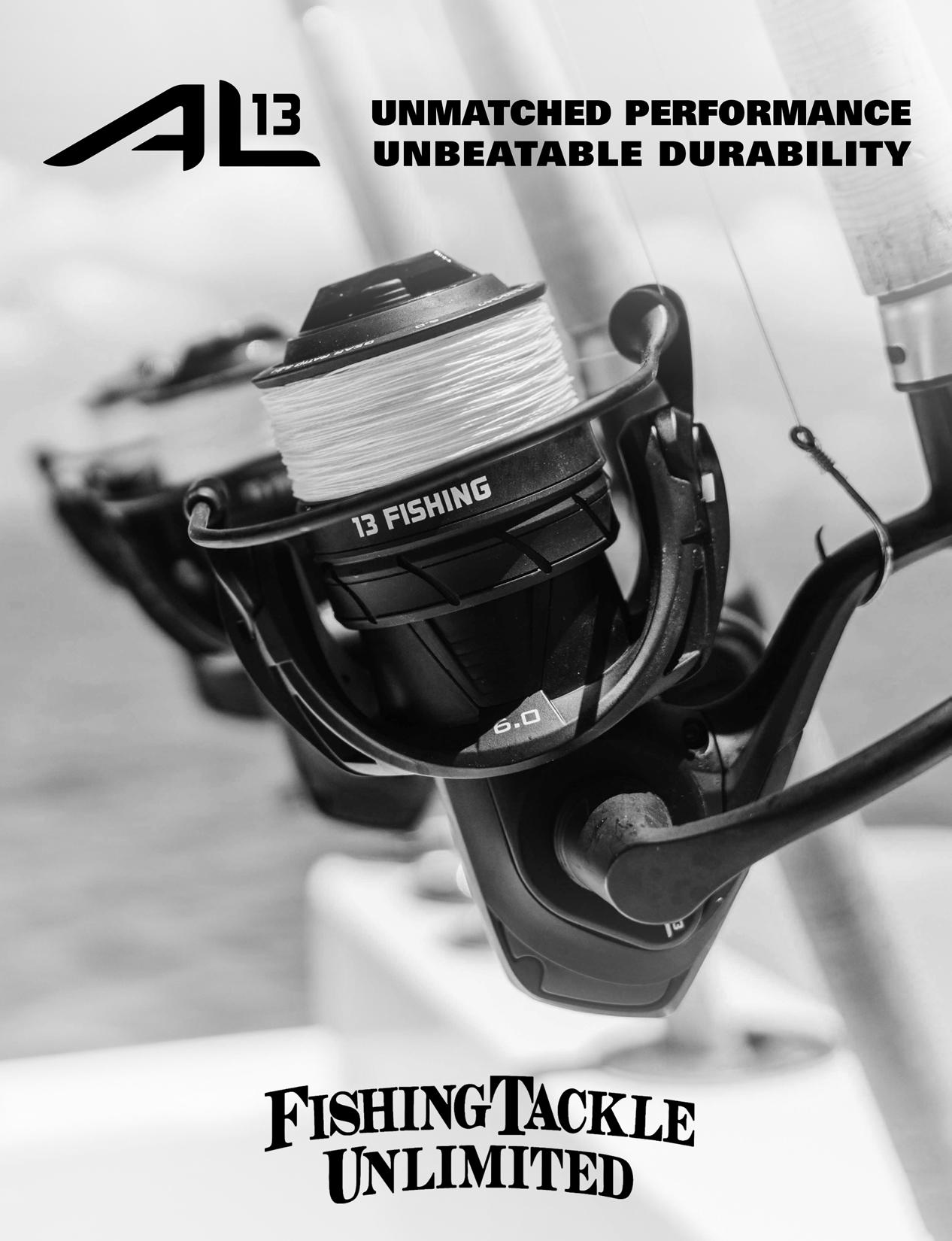




to you by
Brought





Texas Saltwater Fishing Magazine l www.texassaltwaterfishingmagazine.com
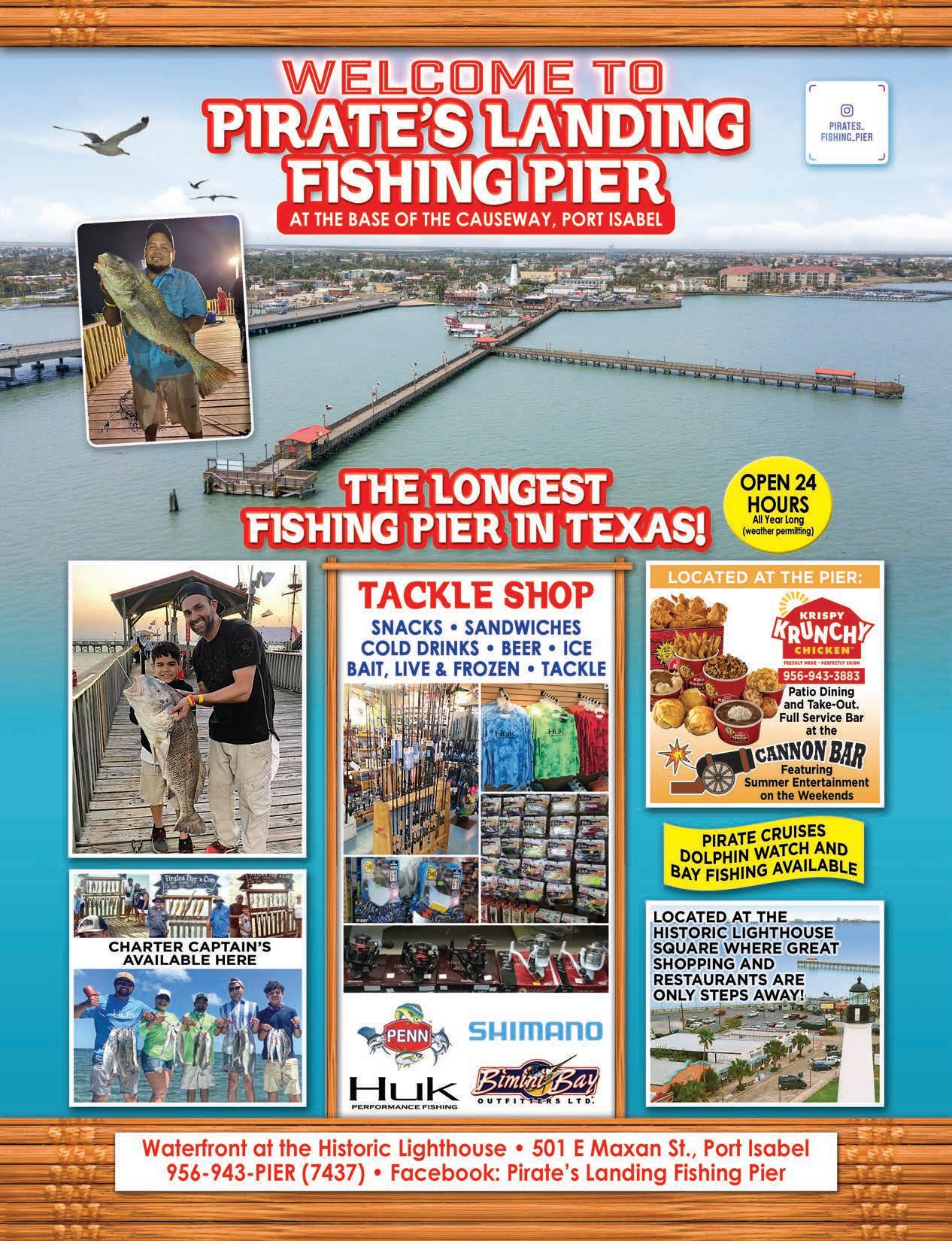


























































































 This chunky one absolutely smoked my Skitter Walk the instant I paused it amidst mullet blanketing the surface. (CPR)
Clint Brown and his dad, Joe, had a blast chasing open water schools of giant reds. Sometimes the jackfish are mixed among them.
This chunky one absolutely smoked my Skitter Walk the instant I paused it amidst mullet blanketing the surface. (CPR)
Clint Brown and his dad, Joe, had a blast chasing open water schools of giant reds. Sometimes the jackfish are mixed among them.




 View The Video Open Camera and hover over QR Code. When link appears at top of screen tap to open in YouTube.
View The Video Open Camera and hover over QR Code. When link appears at top of screen tap to open in YouTube.

 STORY BY KEVIN COCHRAN
STORY BY KEVIN COCHRAN


 Overall, soft plastics prove more effective than other lures during the heat of summer.
Overall, soft plastics prove more effective than other lures during the heat of summer.




 The Captain describes the importance of size and scale in the process of data analysis.
The Captain describes the importance of size and scale in the process of data analysis.









 Amy on a windy day with Capt. Docky Smith at Long Island, Bahamas.
Amy on a windy day with Capt. Docky Smith at Long Island, Bahamas.
 STORY BY JOE RICHARD
STORY BY JOE RICHARD





















 Chris McKinley – Trout Tagging Texas – Chris@trouttaggingtexas.org
Chris McKinley – Trout Tagging Texas – Chris@trouttaggingtexas.org





































 DAVE ROBERTS SHALLOW WATER FISHING
DAVE ROBERTS SHALLOW WATER FISHING


 Dave Roberts is an avid kayak-fishing enthusiast fishing primarily the inshore Upper Coast region with occasional adventures to surf and nearshore Gulf of Mexico.
View The Video Open Camera and hover over QR Code. When link appears at top of screen tap to open in YouTube.
Dave Roberts is an avid kayak-fishing enthusiast fishing primarily the inshore Upper Coast region with occasional adventures to surf and nearshore Gulf of Mexico.
View The Video Open Camera and hover over QR Code. When link appears at top of screen tap to open in YouTube.





















































 Mr. Bennett with a bonus redfish on spinning tackle after the fly bite slowed.
Mr. Bennett with a bonus redfish on spinning tackle after the fly bite slowed.
















 Bink Grimes is a full-time fishing and hunting guide, freelance writer and photographer, and owner of Sunrise Lodge on Matagorda Bay.
Bink Grimes is a full-time fishing and hunting guide, freelance writer and photographer, and owner of Sunrise Lodge on Matagorda Bay.

































 Made in USA
C.A.L. 5” Swim Bait
C.A.L. 4” Shad Tail
C.A.L. 3” Shad Tail
C.A.L. 4” Jerk Bait
C.A.L. 5.5” Jerk Bait
C.A.L. Paddle Tail
Made in USA
C.A.L. 5” Swim Bait
C.A.L. 4” Shad Tail
C.A.L. 3” Shad Tail
C.A.L. 4” Jerk Bait
C.A.L. 5.5” Jerk Bait
C.A.L. Paddle Tail






































 Ellis Halverson East Matagorda Bay - first trout!
Ben Lalumia with Bobby Ward Mesquite Bay - first jack!
Theo McCollum, Jr. Galveston Bay - 4 lb black drum, first catch!
Cal Bowers Port Mansfield - trout
Maddie Goodrich Shoalwater Bay - 25” red
Joel Carter Port Mansfield - trout
Mark Mullin 40” red while wade fishing
Ellis Halverson East Matagorda Bay - first trout!
Ben Lalumia with Bobby Ward Mesquite Bay - first jack!
Theo McCollum, Jr. Galveston Bay - 4 lb black drum, first catch!
Cal Bowers Port Mansfield - trout
Maddie Goodrich Shoalwater Bay - 25” red
Joel Carter Port Mansfield - trout
Mark Mullin 40” red while wade fishing




























